6.1: The Indus River Valley Civilizations
6.1.1: The Indus River Valley Civilization
The Indus River Valley Civilization, located in modern Pakistan,
was one of the world’s three earliest widespread societies.
Learning Objective
Identify the importance of the discovery of the Indus River Valley Civilization
Key Points
-
The Indus Valley Civilization
(also known as the Harappan Civilization) was a Bronze Age society extending
from modern northeast Afghanistan to Pakistan and northwest India. - The civilization developed in
three phases: Early Harappan Phase (3300 BCE-2600 BCE), Mature Harappan Phase
(2600 BCE-1900 BCE), and Late Harappan Phase (1900 BCE-1300 BCE). - Inhabitants of the ancient Indus
River valley developed new techniques in handicraft, including Carnelian
products and seal
carving, and metallurgy with
copper, bronze, lead, and tin. -
Sir John Hubert Marshall led an
excavation campaign in 1921-1922, during which he discovered the ruins of the
city of Harappa. By 1931, the Mohenjo-daro site had been mostly excavated by
Marshall and Sir Mortimer Wheeler. By 1999, over 1,056 cities and settlements of
the Indus Civilization were located.
Key Terms
- seal
-
An emblem used as
a means of authentication. Seal can refer to an impression in paper, wax, clay, or other medium. It can also refer to the device used. - metallurgy
-
The scientific and mechanical technique of working with bronze. copper, and tin.
The Indus Valley Civilization existed through its
early years of 3300-1300 BCE, and its mature period of
2600-1900 BCE. The area of this civilization extended along the Indus River
from what today is northeast Afghanistan, into Pakistan and northwest India. The
Indus Civilization was the most widespread of the three early civilizations of
the ancient world, along with Ancient Egypt and Mesopotamia. Harappa and Mohenjo-daro were thought to be the two great
cities of the Indus Valley Civilization, emerging around 2600 BCE along the
Indus River Valley in the Sindh and Punjab provinces of Pakistan. Their discovery
and excavation in the 19th and 20th centuries provided important archaeological
data about ancient cultures.
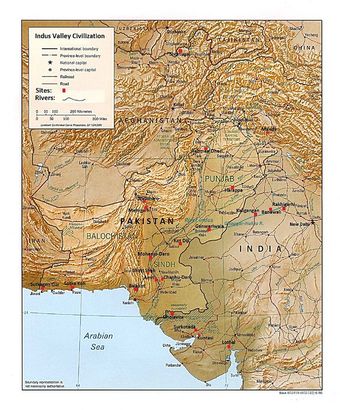
Map of the Indus Valley Civilization
The major sites of the Indus Valley Civilization.
Indus Valley Civilization
The
Indus Valley Civilization was one
of the three “Ancient East” societies that are considered to be the cradles of civilization
of the old world of man, and are among the most widespread; the other two “Ancient East” societies are Mesopotamia and Pharonic Egypt. The lifespan of
the Indus Valley Civilization is often separated into three phases: Early Harappan Phase
(3300-2600 BCE), Mature Harappan Phase (2600-1900 BCE) and Late Harappan Phase
(1900-1300 BCE).
At its peak, the Indus Valley
Civilization may had a population of over five million people. It is considered a Bronze
Age society, and inhabitants of the ancient Indus River Valley developed new
techniques in metallurgy—the science of working with copper, bronze, lead, and
tin. They also performed intricate handicraft, especially using products made
of the semi-precious gemstone Carnelian, as well as seal carving—
the cutting
of patterns into the bottom face of a seal used for stamping. The Indus cities
are noted for their urban planning, baked brick houses, elaborate
drainage systems, water supply systems, and clusters of large, non-residential
buildings.
The
Indus Valley Civilization is also known as the Harappan Civilization, after
Harappa, the first of its sites to be excavated in the 1920s, in what was then
the Punjab province of British India and is now in Pakistan. The discoveries of
Harappa, and the site of its fellow Indus city Mohenjo-daro, were the
culmination of work beginning in 1861 with the founding of the Archaeological
Survey of India in the British Raj, the common name for British imperial rule
over the Indian subcontinent from 1858 through 1947.
Harappa
and Mohenjo-daro
Harappa
was a fortified city in modern-day Pakistan that is believed to have been home
to as many as 23,500 residents living in sculpted houses with flat roofs made
of red sand and clay. The city spread over 150 hectares (370 acres) and had
fortified administrative and religious centers of the same type used in Mohenjo-daro.
The modern village of Harappa, used as a railway station during the Raj, is six
kilometers (3.7 miles) from the ancient city site, which suffered heavy damage
during the British period of rule.
Mohenjo-daro
is thought to have been built in the 26th century BCE and became not only the
largest city of the Indus Valley Civilization but one of the world’s earliest,
major urban centers. Located west of the Indus River in the Larkana District,
Mohenjo-daro was one of the most sophisticated cities of the period, with
sophisticated engineering and urban planning. Cock-fighting was thought to have
religious and ritual significance, with domesticated chickens bred for religion
rather than food (although the city may have been a point of origin for the
worldwide domestication of chickens). Mohenjo-daro was abandoned around 1900 BCE
when the Indus Civilization went into sudden decline.
The
ruins of Harappa were first described in 1842 by Charles Masson in his book, Narrative of Various Journeys in Balochistan,
Afghanistan, the Panjab, & Kalât. In 1856, British engineers John and
William Brunton were laying the East Indian Railway Company line connecting the
cities of Karachi and Lahore, when their crew discovered hard, well-burnt bricks
in the area and used them for ballast for the railroad track,
unwittingly dismantling the ruins of the ancient city of Brahminabad.
Excavations
In 1912, John Faithfull Fleet, an English civil servant working with the
Indian Civil Services, discovered several Harappan seals.
This prompted an excavation campaign from 1921-1922 by Sir John Hubert Marshall, Director-General
of the Archaeological Survey of India, which resulted in the
discovery of Harappa. By 1931, much of
Mohenjo-Daro had been excavated, while the next director of the Archaeological
Survey of India, Sir Mortimer Wheeler, led additional excavations.
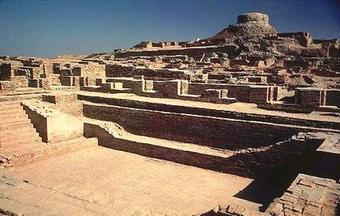
Excavated Ruins of Mohenjo-daro
The Great Bath at Mohenjo-daro, a city in the Indus River Valley Civilization.
The Partition of India, in 1947, divided the country to create the new nation
of Pakistan. The bulk of the archaeological finds that followed were inherited by Pakistan.
By 1999, over 1,056 cities and settlements had been found, of which 96 have
been excavated.
6.1.2: Cities of the Indus Valley Civilization
The Indus River Valley Civilization (IVC) contained urban centers with
well-conceived and organized infrastructure, architecture, and systems of governance.
Learning Objective
Explain the significance of the urban centers in the IVC
Key Points
-
The Indus Valley Civilization
contained more than 1,000 cities and settlements. -
These cities contained
well-organized wastewater drainage systems, trash collection systems, and
possibly even public granaries and
baths. -
Although there were large walls
and citadels,
there is no evidence of monuments, palaces, or temples. -
The uniformity of Harappan
artifacts suggests some form of authority and governance to regulate seals,
weights, and bricks.
Key Terms
- urban planning
-
A technical and
political process concerned with the use of land and design of the urban
environment that guides and ensures the orderly development of settlements and
communities. - granaries
-
A storehouse or room in a barn for threshed grain or animal feed.
- citadels
-
A central area in a city that is heavily fortified.
- Harappa and Mohenjo-daro
-
Two of the major cities of the Indus Valley Civilization during the Bronze Age.
By
2600 BCE, the small Early Harappan communities had become
large urban centers. These cities include Harappa, Ganeriwala, and Mohenjo-daro
in modern-day Pakistan, and Dholavira, Kalibangan, Rakhigarhi, Rupar, and Lothal
in modern-day India. In total, more than 1,052 cities and settlements have been
found, mainly in the general region of the Indus River and its tributaries. The
population of the Indus Valley Civilization may have once been as large as five million.
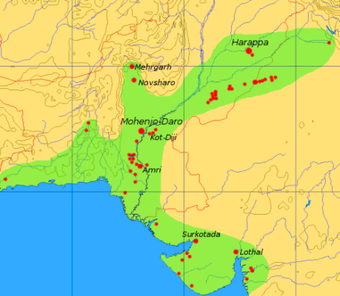
Indus Valley Civilization Sites
This map shows a cluster of Indus Valley Civilization cities and excavation sites along the course of the Indus River in Pakistan.
The
remains of the Indus Valley Civilization cities indicate remarkable organization; there were well-ordered wastewater drainage and trash collection systems, and
possibly even public granaries and baths. Most city-dwellers were artisans and merchants grouped together in
distinct neighborhoods. The quality of urban planning suggests efficient municipal
governments that placed a high priority on hygiene or religious ritual.
Infrastructure
Harappa, Mohenjo-daro, and the recently, partially-excavated Rakhigarhi demonstrate the
world’s first known urban sanitation systems. The ancient Indus systems of
sewerage and drainage developed and used in cities throughout the Indus region
were far more advanced than any found in contemporary urban sites in the Middle
East, and even more efficient than those in many areas of Pakistan and India
today. Individual homes drew water from wells, while waste water was directed
to covered drains on the main streets. Houses opened only to inner courtyards
and smaller lanes, and even the smallest homes on the city outskirts were
believed to have been connected to the system, further supporting the
conclusion that cleanliness was a matter of great importance.
Architecture
Harappans
demonstrated advanced architecture with dockyards, granaries, warehouses, brick
platforms, and protective walls. These massive walls likely protected the
Harappans from floods and may have dissuaded military conflicts. Unlike
Mesopotamia and Ancient Egypt, the inhabitants of the Indus Valley Civilization
did not build large, monumental structures. There is no conclusive evidence of
palaces or temples (or even of kings, armies, or priests), and the largest
structures may be granaries. The city of Mohenjo-daro contains the “Great
Bath,” which may have been a large, public bathing and social area.
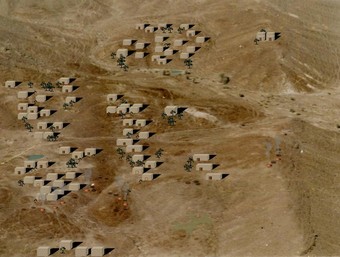
Sokhta Koh
Sokhta Koh, a Harappan
coastal settlement near Pasni, Pakistan, is depicted in a computer
reconstruction. Sokhta Koh means “burnt hill,” and corresponds to the browned-out
earth due to extensive firing of pottery in open pit ovens.
Authority
and Governance
Archaeological
records provide no immediate answers regarding a center of authority, or depictions
of people in power in Harappan society. The extraordinary uniformity of
Harappan artifacts is evident in pottery, seals, weights, and bricks with
standardized sizes and weights, suggesting some form of authority and
governance.
Over time, three major theories have developed concerning Harappan governance
or system of rule. The first is that there was a single state encompassing all
the communities of the civilization, given the similarity in artifacts, the
evidence of planned settlements, the standardized ratio of brick size, and the apparent
establishment of settlements near sources of raw material. The second theory posits
that there was no single ruler, but a number of them representing each of the urban
centers, including Mohenjo-daro, Harappa, and other communities. Finally, experts
have theorized that the Indus Valley Civilization had no rulers as we understand
them, with everyone enjoying equal status.
6.1.3: Harappan Culture
The Indus River Valley Civilization, also known as Harappan, included
its own advanced technology, economy, and culture.
Learning Objective
Identify how artifacts and ruins provided insight into the IRV’s technology, economy, and culture
Key Points
- The Indus River Valley Civilization,
also known as Harappan civilization, developed the first accurate system of
standardized weights and measures, some as accurate as to 1.6 mm. -
Harappans created sculpture, seals,
pottery, and jewelry from materials, such as terracotta, metal, and stone. - Evidence shows Harappans participated
in a vast maritime trade network extending from Central Asia to modern-day
Iraq, Iran, Kuwait, and Syria. - The Indus
Script remains indecipherable without any comparable
symbols, and is thought to have evolved independently of the writing in
Mesopotamia and Ancient Egypt.
Key Terms
- steatite
-
Also known as Soapstone, steatite is a talc-schist, which is a type of metamorphic rock. It is very soft and has been a medium for carving for thousands of years.
- Indus Script
-
Symbols produced by the ancient Indus Valley Civilization.
- chalcolithic period
-
A period also
known as the Copper Age, which lasted from 4300-3200 BCE.
The Indus
Valley Civilization is the earliest known culture of the Indian subcontinent of
the kind now called “urban” (or centered on large municipalities), and the largest
of the four ancient civilizations, which also included Egypt, Mesopotamia, and
China. The society of the Indus River Valley has been dated from the Bronze Age,
the time period from approximately 3300-1300 BCE. It was located in modern-day India and Pakistan, and covered an area as large as Western
Europe.
Harappa and Mohenjo-daro were the two great cities of the Indus Valley
Civilization, emerging around 2600 BCE along the Indus River Valley in the
Sindh and Punjab provinces of Pakistan. Their discovery and excavation in the
19th and 20th centuries provided important archaeological data regarding the
civilization’s technology, art, trade, transportation, writing, and
religion.
Technology
The
people of the Indus Valley, also known as Harappan (Harappa was the first
city in the region found by archaeologists), achieved many notable advances in technology,
including great accuracy in their systems and tools for measuring length and
mass.
Harappans
were among the first to develop a system of uniform weights and measures that conformed
to a successive scale. The smallest division, approximately 1.6 mm, was marked
on an ivory scale found in Lothal, a prominent Indus Valley city in the modern Indian
state of Gujarat. It stands as the smallest division ever recorded on a Bronze
Age scale. Another indication of an advanced measurement system is the fact that
the bricks used to build Indus cities were uniform in size.
Harappans
demonstrated advanced architecture with dockyards, granaries, warehouses, brick
platforms, and protective walls. The ancient Indus systems of sewerage and
drainage developed and used in cities throughout the region were far more
advanced than any found in contemporary urban sites in the Middle East, and even
more efficient than those in many areas of Pakistan and India today.
Harappans
were thought to have been proficient in seal carving, the cutting of patterns
into the bottom face of a seal, and used distinctive seals for the
identification of property and to stamp clay on trade goods. Seals have been
one of the most commonly discovered artifacts in Indus Valley cities, decorated
with animal figures, such as elephants, tigers, and water buffalos.
Harappans also
developed new techniques in metallurgy—the science of working with copper, bronze,
lead, and tin—and performed intricate handicraft using products made of the
semi-precious gemstone, Carnelian.
Art
Indus
Valley excavation sites have revealed a number of distinct examples of the
culture’s art, including sculptures, seals, pottery, gold jewelry, and
anatomically detailed figurines in terracotta, bronze, and steatite—more commonly known as Soapstone.
Among
the various gold, terracotta, and stone figurines found, a figure of a “Priest-King” displayed
a beard and patterned robe. Another figurine in bronze, known as the “Dancing
Girl,” is only 11 cm. high and shows a female figure in a pose that suggests the
presence of some choreographed dance form enjoyed by members of the
civilization. Terracotta works also included cows, bears, monkeys, and dogs. In
addition to figurines, the Indus River Valley people are believed to have created
necklaces, bangles, and other ornaments.
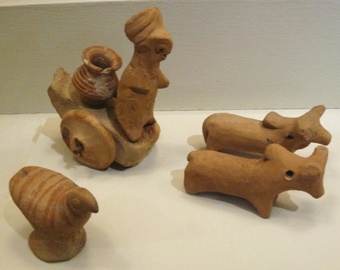
Miniature Votive Images or Toy Models from Harappa, c. 2500 BCE
The Indus River Valley Civilization created figurines from terracotta, as well as bronze and steatite. It is still unknown whether these figurines have religious significance.
Trade and
Transportation
The
civilization’s economy appears to have depended significantly on trade, which
was facilitated by major advances in transport technology. The Harappan
Civilization may have been the first to use wheeled transport, in the form of
bullock carts that are identical to those seen throughout South Asia today. It
also appears they built boats and watercraft—a claim supported by
archaeological discoveries of a massive, dredged canal, and what is regarded as
a docking facility at the coastal city of Lothal.
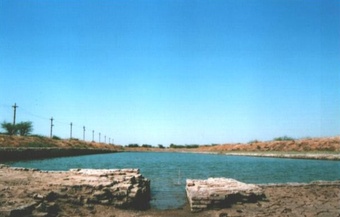
The docks and canal in the ancient city of Lothal, located in modern India
Archaeological evidence suggests that the Indus River Valley Civilization constructed boats and may have participated in an extensive maritime trade network.
Trade
focused on importing raw materials to be used in Harappan city workshops, including minerals from Iran and Afghanistan, lead and copper from other parts
of India, jade from China, and cedar wood floated down rivers from the
Himalayas and Kashmir. Other trade goods included terracotta pots, gold,
silver, metals, beads, flints for making tools, seashells, pearls, and colored gem
stones, such as lapis lazuli and turquoise.
There
was an extensive maritime trade network operating between the Harappan and Mesopotamian
civilizations. Harappan seals and jewelry have been found at archaeological sites
in regions of Mesopotamia, which includes most of modern-day Iraq, Kuwait, and
parts of Syria. Long-distance sea trade over bodies of water, such as the
Arabian Sea, Red Sea and the Persian Gulf, may have become feasible with the
development of plank watercraft that was equipped with a single central mast supporting
a sail of woven rushes or cloth.
During
4300-3200 BCE of the Chalcolithic period,
also known as the Copper
Age, the Indus Valley Civilization area shows ceramic similarities with
southern Turkmenistan and northern Iran. During the Early Harappan period
(about 3200-2600 BCE), cultural similarities in pottery, seals, figurines, and
ornaments document caravan trade with Central Asia and the Iranian plateau.
Writing
Harappans
are believed to have used Indus Script, a language consisting of symbols. A
collection of written texts on clay and stone tablets unearthed at Harappa,
which have been carbon dated 3300-3200 BCE, contain trident-shaped, plant-like markings. This Indus Script suggests that writing developed
independently in the Indus River Valley Civilization from the script employed
in Mesopotamia and Ancient Egypt.

Indus Script
These ten Indus Script symbols were found on a “sign board” in the ancient city of Dholavira.
As
many as 600 distinct Indus symbols have been found on seals, small tablets,
ceramic pots, and more than a dozen other materials. Typical Indus inscriptions
are no more than four or five characters in length, most of which are very
small. The longest on a single surface, which is less than 1 inch (or 2.54 cm.) square, is 17 signs long. The characters are largely pictorial, but include
many abstract signs that do not appear to have changed over time.
The inscriptions are thought to have been primarily written from right
to left, but it is unclear whether this script constitutes a complete language.
Without a “Rosetta Stone” to use as a comparison with other writing systems, the
symbols have remained indecipherable to linguists and archaeologists.
Religion
The
Harappan religion remains a topic of speculation. It has been widely suggested
that the Harappans worshipped a mother goddess who symbolized fertility. In
contrast to Egyptian and Mesopotamian civilizations, the Indus Valley
Civilization seems to have lacked any temples or palaces that would give clear
evidence of religious rites or specific deities. Some Indus Valley seals show a
swastika symbol, which was included in later Indian religions including
Hinduism, Buddhism, and Jainism.
Many
Indus Valley seals also include the forms of animals, with some depicting them
being carried in processions, while others showing chimeric creations, leading
scholars to speculate about the role of animals in Indus Valley religions. One
seal from Mohenjo-daro shows a half-human, half-buffalo monster attacking a
tiger. This may be a reference to the Sumerian myth of a monster created by Aruru,
the Sumerian earth and fertility goddess, to fight Gilgamesh, the hero of an ancient Mesopotamian
epic poem. This is a further suggestion of international trade in
Harappan culture.
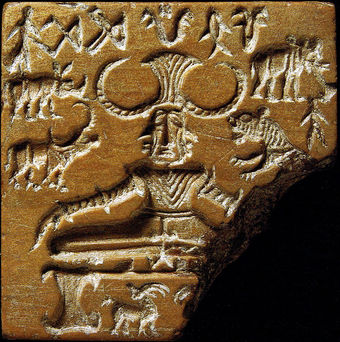
The “Shiva Pashupati” seal
This seal was excavated in Mohenjo-daro and depicts a seated and possibly ithyphallic figure, surrounded by animals.
6.1.4: Disappearance of the Indus Valley Civilization
The Indus Valley Civilization declined around 1800 BCE due to climate
change and migration.
Learning Objective
Discuss the causes for the disappearance of the Indus Valley Civilization
Key Points
- One theory suggested that a nomadic, Indo-European tribe, called the Aryans, invaded and conquered the Indus Valley Civilization.
- Many scholars now believe the collapse of the Indus Valley Civilization was caused by climate change.
- The eastward shift of monsoons may have reduced the water supply, forcing the Harappans of the Indus River Valley to migrate and establish smaller villages and isolated farms.
- These small communities could not produce the agricultural surpluses needed to support cities, which where then abandoned.
Key Terms
- Indo-Aryan Migration theory
-
A theory suggesting the Harappan culture of the Indus River Valley was assimilated during a migration of the Aryan people into northwest India.
- monsoon
-
Seasonal changes in atmospheric circulation and precipitation; usually winds that bring heavy rain once a year.
- Aryans
-
A nomadic, Indo-European tribe called the Aryans suddenly overwhelmed and conquered the Indus Valley Civilization.
The great
Indus Valley Civilization, located in modern-day India and Pakistan, began to
decline around 1800 BCE. The civilization eventually disappeared
along with its two great cities, Mohenjo-daro and Harappa. Harappa lends its name
to the Indus Valley people because it was the civilization’s first city to be
discovered by modern archaeologists.
Archaeological
evidence indicates that trade with Mesopotamia, located largely in modern Iraq, seemed
to have ended. The advanced drainage system and baths of the great cities were
built over or blocked. Writing began to disappear and the standardized weights
and measures used for trade and taxation fell out of use.
Scholars
have put forth differing theories to explain the disappearance of the Harappans,
including an Aryan Invasion and climate change marked by overwhelming monsoons.
The Aryan
Invasion Theory (c. 1800-1500 BC)
The Indus
Valley Civilization may have met its demise due to invasion. According to one
theory by British archaeologist Mortimer Wheeler, a nomadic, Indo-European
tribe, called the Aryans, suddenly overwhelmed and conquered the Indus River
Valley.
Wheeler,
who was Director-General of the Archaeological Survey of India from 1944 to
1948, posited that many unburied corpses found in the top levels of the Mohenjo-daro
archaeological site were victims of war. The theory suggested that by using
horses and more advanced weapons against the peaceful Harappan people, the
Aryans may have easily defeated them.
Yet shortly
after Wheeler proposed his theory, other scholars dismissed it by explaining
that the skeletons were not victims of invasion massacres, but rather the
remains of hasty burials. Wheeler himself eventually admitted that the theory
could not be proven and the skeletons indicated only a final phase of human
occupation, with the decay of the city structures likely a result of it becoming
uninhabited.
Later
opponents of the invasion theory went so far as to state that adherents to the idea
put forth in the 1940s were subtly justifying the British government’s policy
of intrusion into, and subsequent colonial rule over, India.
Various
elements of the Indus Civilization are found in later cultures, suggesting the
civilization did not disappear suddenly due to an invasion. Many scholars came
to believe in an Indo-Aryan Migration theory stating that the Harappan culture
was assimilated during a migration of the Aryan people into northwest India.
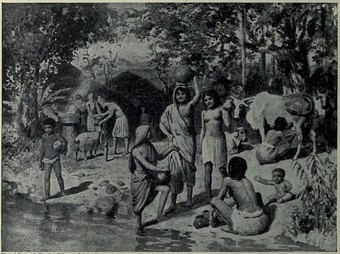
Aryans in India
An early 20th-century depiction of Aryan people settling in agricultural villages in India.
The Climate
Change Theory (c. 1800-1500 BC)
Other
scholarship suggests the collapse of Harappan society resulted from climate
change. Some experts believe the drying of the Saraswati River, which began
around 1900 BCE, was the main cause for climate change, while others conclude
that a great flood struck the area.
Any
major environmental change, such as deforestation, flooding or droughts due to
a river changing course, could have had disastrous effects on Harappan society, such
as crop failures, starvation, and disease. Skeletal evidence suggests many
people died from malaria, which is most often spread by mosquitoes. This also
would have caused a breakdown in the economy and civic order within the urban
areas.
Another disastrous change in the Harappan climate might have been
eastward-moving monsoons, or winds that bring heavy rains. Monsoons can be both
helpful and detrimental to a climate, depending on whether they support or
destroy vegetation and agriculture. The monsoons that came to the Indus River
Valley aided the growth of agricultural surpluses, which supported the
development of cities, such as Harappa. The population came to rely on seasonal
monsoons rather than irrigation, and as the monsoons
shifted eastward, the water supply would have dried up.
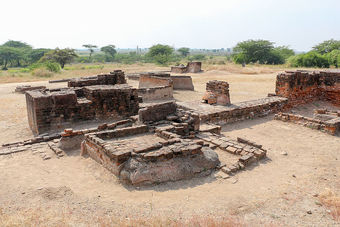
Ruins of the city of Lothal
Archaeological evidence
shows that the site, which had been a major city before the downfall of the
Indus Valley Civilization, continued to be inhabited by a much smaller
population after the collapse. The few people who remained in Lothal did not repair
the city, but lived in poorly-built houses and reed huts instead.
By
1800 BCE, the Indus Valley climate grew cooler and drier, and a tectonic event
may have diverted the Ghaggar Hakra river system toward the Ganges Plain. The Harappans may have migrated
toward the Ganges basin in the east, where they established villages
and isolated farms.
These small communities could not produce the same agricultural
surpluses to support large cities. With the reduced production of goods, there
was a decline in trade with Egypt and Mesopotamia. By around 1700 BCE, most of
the Indus Valley Civilization cities had been abandoned.
6.2: Indo-European Civilizations
6.2.1: The Indo-Aryan Migration and the Vedic Period
Different theories explain the Vedic Period, c. 1200 BCE, when Indo-Aryan
people on the Indian subcontinent migrated to the Ganges Plain.
Learning Objective
Describe the defining characteristics of the Vedic Period and the cultural consequenes of the Indo-Aryan Migration
Key Points
-
The Indo-Aryans were
part of an expansion into the Indus Valley and Ganges
Plain from
1800-1500 BCE. This is explained through Indo-Aryan Migration and Kurgan theories. - The Indo-Aryans continued to
settle the Ganges Plain, bringing their distinct religious beliefs and
practices. - The Vedic Period (c. 1750-500 BCE)
is named for the
Vedas, the oldest scriptures in Hinduism, which were composed during this period. The period can be divided into the Early Vedic (1750-1000 BCE) and Later Vedic
(1000-500 BCE) periods.
Key Terms
- Rig-Veda
-
A sacred
Indo-Aryan collection of Vedic Sanskrit hymns. It is counted among the four canonical
sacred texts of Hinduism, known as the Vedas. - the Vedas
-
The oldest
scriptures of Hinduism composed in Vedic Sanskrit, and originating in ancient
India during the Vedic Period (c. 1750-500 BCE). - Ganges Plain
-
A large, fertile
plain encompassing most of northern and eastern India, where the Indo-Aryans
migrated.
Scholars
debate the origin of Indo-Aryan peoples in northern India. Many have rejected
the claim of Indo-Aryan origin outside of India entirely, claiming the
Indo-Aryan people and languages originated in India. Other origin hypotheses include
an Indo-Aryan Migration in the period 1800-1500 BCE, and a fusion
of the nomadic people known as Kurgans. Most history of this period is derived
from the Vedas, the oldest scriptures in Hinduism, which help chart the
timeline of an era from 1750-500 BCE, known as the Vedic Period.
The
Indo-Aryan Migration (1800-1500 BCE)
Foreigners
from the north are believed to have migrated to India and settled in the Indus
Valley and Ganges Plain from 1800-1500 BCE. The most prominent of these groups
spoke Indo-European languages and were called Aryans, or “noble
people” in the Sanskrit language. These Indo-Aryans were a branch of the
Indo-Iranians, who originated in present-day northern Afghanistan. By 1500 BCE,
the Indo-Aryans had created small herding and agricultural communities across
northern India.
These
migrations took place over several centuries and likely did not involve an
invasion, as hypothesized by British archaeologist Mortimer Wheeler in the
mid-1940s. Wheeler, who was Director-General of the Archaeological Survey of
India from 1944 to 1948, suggested that a nomadic, Indo-European tribe, called
the Aryans, suddenly overwhelmed and conquered the Indus River Valley. He based
his conclusions on the remains of unburied corpses found in the top levels of
the archaeological site of Mohenjo-daro, one of the great cities of the Indus
Valley Civilization, whom he said were victims of war. Yet shortly after
Wheeler proposed his theory, other scholars dismissed it by explaining that the
skeletons were not those of victims of invasion massacres, but rather the remains of
hasty burials. Wheeler himself eventually admitted that the theory could not be
proven.
The Kurgan
Hypothesis
The
Kurgan Hypothesis is the most widely accepted scenario of Indo-European
origins. It postulates that people of a so-called Kurgan Culture, a grouping of
the Yamna or Pit Grave culture and its predecessors, of the Pontic Steppe were the speakers of the Proto-Indo-European language. According to this theory, these
nomadic pastoralists expanded throughout
the Pontic-Caspian steppe and into Eastern Europe by early 3000 BCE. The Kurgan
people may have been mobile because of their domestication of horses and later use
of the chariot.
The Vedic
Period (c. 1750-500 BCE)
The
Vedic Period refers to the time in history from approximately 1750-500 BCE, during
which Indo-Aryans settled into northern India, bringing with them specific religious
traditions. Most history of this period is derived from the Vedas, the oldest
scriptures in the Hindu religion, which were composed by the Aryans in Sanskrit.
Vedic
Civilization is believed to have been centered in the northwestern parts of the
Indian subcontinent and spread around 1200 to the Ganges Plain, a 255-million
hectare area (630 million acres) of flat, fertile land named after the Ganges
River and covering most of what is now northern and eastern India, eastern
parts of Pakistan, and most of Bangladesh. Many scholars believe Vedic
Civilization was a composite of the Indo-Aryan and Harappan, or Indus Valley,
cultures.
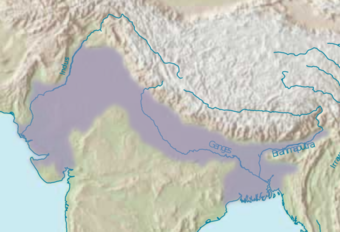
The Ganges Plain (Indo-Gangetic Plain)
The Ganges Plain is supported by the Indus and Ganges river systems. The Indo-Aryans settled various parts of the plain during their migration and the Vedic Period.
Early
Vedic Period (c. 1750-1000 BCE)
The
Indo-Aryans in the Early Vedic Period, approximately 1750-1000 BCE, relied
heavily on a pastoral, semi-nomadic economy with limited agriculture. They
raised sheep, goats, and cattle, which became symbols of wealth.
The
Indo-Aryans also preserved collections of religious and literary works by memorizing
and reciting them, and handing them down from one generation to the next in their
sacred language, Sanskrit. The Rigveda, which was likely composed during
this time, contains several mythological and poetical accounts of the origins
of the world, hymns praising the gods, and ancient prayers for life and
prosperity.
Organized
into tribes, the Vedic Aryans regularly clashed over land and resources. The Rigveda describes the most notable of
these conflicts, the Battle of the Ten Kings, between the Bharatas tribe and a
confederation of ten competing tribes on the banks of what is now the Ravi River
in northwestern India and eastern Pakistan. Led by their king, Sudas, the
Bharatas claimed victory and merged with the defeated Purus tribe to form the
Kuru, a Vedic tribal union in northern India.
Later
Vedic Period (c. 1000-500 BCE)
After
the 12th century BCE, Vedic society transitioned from semi-nomadic to settled
agriculture. From approximately 1000-500 BCE, the development of iron axes and
ploughs enabled the Indo-Aryans to settle the thick forests on the western
Ganges Plain.
This agricultural expansion led to an increase in trade and competition
for resources, and many of the old tribes coalesced to form larger political
units. The Indo-Aryans cultivated wheat, rice and barley and implemented new
crafts, such as carpentry, leather work, tanning, pottery, jewelry crafting, textile
dying, and wine making.
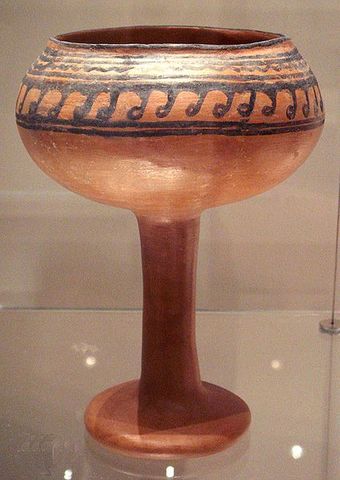
Ceramic goblet from Navdatoli, Malwa, c. 1300 BCE
As the Indo-Aryans developed an agricultural society during the Later Vedic Period (c. 1000-500), they further developed crafts, such as pottery.
Economic
exchanges were conducted through gift giving, particularly between kings and
priests, and barter using cattle as a unit of currency. While gold, silver,
bronze, copper, tin, and lead are mentioned in some hymns as trade items,
there is no indication of the use of coins.
The
invasion of Darius I (a Persian ruler of the vast Achaemenid Empire that stretched
into the Indus Valley) in the early 6th century BCE marked the beginning of
outside influence in Vedic society. This continued into what became the Indo-Greek
Kingdom, which covered various parts of South Asia and was centered mainly in modern
Afghanistan and Pakistan.
6.2.2: The Caste System
A caste system developed among Indo-Aryans of the Vedic Period,
splitting society into four major groups.
Learning Objective
Explain the history of the caste system
Key Points
-
The institution of the caste system,
influenced by stories of the gods in the Rig-Veda epic,
assumed and reinforced the idea that lifestyles, occupations, ritual statuses,
and social statuses were inherited. - Aryan society
was patriarchal in the Vedic Period, with men in positions of authority and
power handed down only through the male line. - There were four classes in the
caste system: Brahmins (priests and scholars), Kshatriyas (kings, governors, and
warriors), Vaishyas (cattle herders, agriculturists, artisans,
and merchants), and Shudras (laborers and service providers). A fifth group, Untouchables,
was excluded from the caste system and historically performed the undesirable
work. -
The caste system may have been
more fluid in Aryan India than it is in modern-day India.
Key Terms
- jatis
-
The term used to
denote the thousands of clans, tribes, religions, communities and sub-communities
in India. - varnas
-
The four broad
ranks of the caste system in the Indo-Aryan culture, which included Brahmins
(priests and scholars), Kshatriyas (kings, governors and warriors), Vaishyas
(cattle herders, agriculturists, artisans, and merchants), and Shudras
(laborers and service providers).
Caste
systems through which social status was inherited developed independently in ancient
societies all over the world, including the Middle East, Asia, and Africa. The
caste system in ancient India was used to establish separate classes of inhabitants
based upon their social positions and employment functions in the community.
These roles and their importance, including the levels of power and significance
based on patriarchy, were influenced by stories of the gods in the Rig-Veda
epic.
Origins
The
caste system in India may have several origins, possibly starting with the
well-defined social orders of the Indo-Aryans in the Vedic Period, c. 1750-500
BCE. The Vedas were ancient scriptures, written
in the Sanskrit language, which contained hymns, philosophies, and rituals handed
down to the priests of the Vedic religion. One of these four sacred canonical
texts, the Rig-Veda, described the origins of the world and points to the gods
for the origin of the caste system.
The castes were a form of social stratification in Aryan India characterized
by the hereditary transmission of lifestyle, occupation, ritual status, and
social status. These social distinctions may have been more fluid in ancient
Aryan civilizations than in modern India, where castes still exist but sociologists
are observing inter-caste marriages and interactions becoming more fluid and
less rigid.
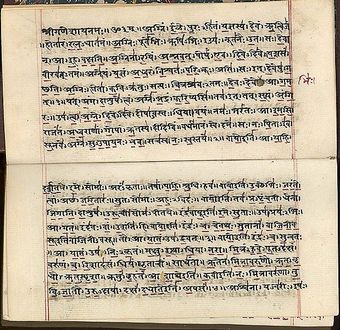
The Rig-Veda
A page of the Rig-Veda,
one of the four sacred Veda texts, which described the origins of the world and
the stories of the gods. The Rig-Veda influenced the development of the
patriarchal society and the caste systems in Aryan India.
Structure
The
classes, known as varnas, enforced
divisions in the populations that still affect this area of the world today. By
around 1000 BCE, the Indo-Aryans developed four main caste distinctions:
Brahamin, consisting of priests, scholars, and teachers; Kshatriyas, the kings,
governors, and warriors; Vaishyas, comprising agriculturists, artisans, and
merchants; and Sudras, the service providers and artisans who were originally
non-Aryans but were admitted to Vedic society.
Each
varna was divided into jatis, or sub-castes, which identified the
individual’s occupation and imposed marriage restrictions. Marriage was only
possible between members of the same jati or two that were very close. Both
varnas and jatis determined a person’s purity level. Members of higher varnas
or jatis had higher purity levels, and if contaminated by members of lower
social groups, even by touch, they would have to undergo extensive cleansing
rites.
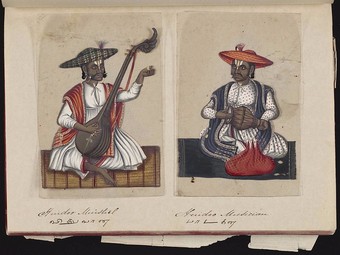
Castes in India
A page from the manuscript Seventy-two Specimens of Castes in India, which consists of 72 full-color hand-painted images of men and women of the various castes and religious and ethnic groups found in Madura, India at that time. Each drawing was made on mica, a transparent, flaky mineral that splits into thin, transparent sheets. As indicated on the presentation page, the album was compiled by the Indian writing master at an English school established by American missionaries in Madura, and given to the Reverend William Twining. The manuscript shows Indian dress and jewelry adornment in the Madura region as they appeared before the onset of Western influences on South Asian dress and style. Each illustrated portrait is captioned in English and in Tamil, and the title page of the work includes English, Tamil, and Telugu.
As
the Aryans expanded their influence, newly conquered groups were assimilated
into society by forming a new group below the Sudras, outside the caste system.
These outcasts were called Untouchables, as they performed the least desirable
activities and jobs, such as dealing with dead bodies, cleaning toilets and
washrooms, and tanning and dyeing leather.
Development
of Patriarchy
Society
during the Vedic Period (c.1750-500 BCE) was patriarchal and patrilineal, meaning to trace ancestral
heritage through the male line. Marriage and childbearing were especially
important to maintain male lineage. The institution of marriage was important, and different types of marriages—monogamy, polygyny and polyandry—are
mentioned in the Rig Veda. All priests, warriors, and tribal chiefs were men, and
descent was always through the male line.
In
other parts of society, women had no public authority; they only were able to
influence affairs within their own homes. Women were to remain subject to the
guidance of males in their lives, beginning with their father, then husband, and
lastly their sons. Male gods were considered more important than female gods.
These distinct gender roles may have contributed to the social stratification
of the caste system.
Enduring
Influence
The
caste system that influenced the social structure of Aryan India has been
maintained to some degree into modern-day India. The caste system survived for
over two millennia, becoming one of the basic features of traditional Hindu
society. Although the Constitution of India, the supreme law document of the Republic
of India, formally abolished the caste system in 1950, some people maintain prejudices
against members of lower social classes.
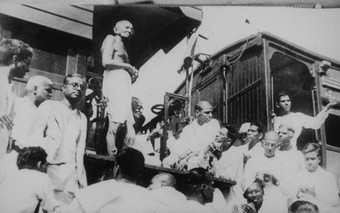
Gandhi at Madras, 1933
Mahatma Gandhi visits Madras, now Chennai, during a tour of India in 1933. As leader of the Indian independence movement, Gandhi frequently spoke out against discrimination created by the caste system.
6.2.3: Sanskrit
Vedic Sanskrit evolved to Classical Sanskrit, which has
influenced modern Indian languages and is used in religious rites.
Learning Objective
Explain the importance of Sanskrit
Key Points
-
Sanskrit is originated as Vedic
Sanskrit as early as 1700-1200 BCE, and was orally preserved as a part of the
Vedic chanting tradition. - The scholar Panini standardized
Vedic Sanskrit into Classical Sanskrit when he defined the grammar, around 500
BCE. - Vedic Sanskrit is the language of the
Vedas, the oldest scriptures of Hinduism. - Knowledge of Sanskrit became a
marker of high social class during and after the Vedic Period.
Key Terms
- Hinduism
-
The dominant
religion of the modern Indian subcontinent, which makes use of Sanskrit in its
texts and practices. - Panini
-
The scholar who standardized the grammar of Vedic Sanskrit to create Classical Sanskrit.
Sanskrit
is the primary sacred language of Hinduism, and has been used as a
philosophical language in the religions of Hinduism, Buddhism, and Jainism. Sanskrit is a standardized
dialect of Old Indo-Aryan, originating as Vedic Sanskrit as early as 170001200
BCE.
One
of the oldest Indo-European languages for which substantial documentation
exists, Sanskrit is believed to have been the general language of the greater
Indian Subcontinent in ancient times. It is still used today in Hindu religious
rituals, Buddhist hymns and chants, and Jain texts.
Origins
Sanskrit
traces its linguistic ancestry to Proto-Indo-Iranian and ultimately to
Proto-Indo-European languages, meaning that it can be traced historically back
to the people who spoke Indo-Iranian, also called the Aryan languages, as well as the
Indo-European languages, a family of several hundred related languages and
dialects. Today, an estimated 46% of humans speak some form of Indo-European
language. The most widely-spoken Indo-European languages are English, Hindi, Bengali,
Punjabi, Spanish, Portuguese, and Russian, each with over 100 million speakers.
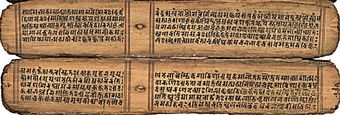
Sanskrit manuscript on palm-leaf, in Bihar or Nepal, 11th century
Sanskrit evolved from Proto-Indo-European languages and was used to write the Vedas, the Hindu religious texts compiled between 1500-500 BCE.
Vedic
Sanskrit is the language of the Vedas, the most ancient Hindu scripts, compiled c. 1500-500 BCE. The Vedas contain hymns, incantations called Samhitas, and
theological and philosophical guidance for priests of the Vedic religion. Believed
to be direct revelations to seers among the early Aryan people of India, the
four chief collections are the Rig Veda, Sam Veda, Yajur Vedia, and Atharva
Veda. (Depending on the source consulted, these are spelled, for example,
either Rig Veda or Rigveda.)
Vedic
Sanskrit was orally preserved as a part of the Vedic chanting tradition,
predating alphabetic writing in India by several centuries. Modern linguists
consider the metrical hymns of the Rigveda Samhita, the
most ancient layer
of text in the Vedas, to have been composed by many authors over several
centuries of oral tradition.
Sanskrit Literature
Sanskrit
Literature began with the spoken or sung literature of the Vedas from c. 1500
BCE, and continued with the oral tradition of the Sanskrit Epics of Iron Age
India, the period after the Bronze Age began, around 1200 BCE. At approximately
1000 BCE, Vedic Sanskrit began the transition from a first language to a second
language of religion and learning.
Around 500 BCE, the ancient scholar Panini standardized the grammar of
Vedic Sanskrit, including 3,959 rules of syntax, semantics, and morphology (the study of words and how they are formed and relate to each other). Panini’s Astadhyayi is the most important of the surviving
texts of Vyakarana, the linguistic
analysis of Sanskrit, consisting of eight chapters laying out his rules and their
sources. Through this standardization, Panini helped create what is now known
as Classical Sanskrit.
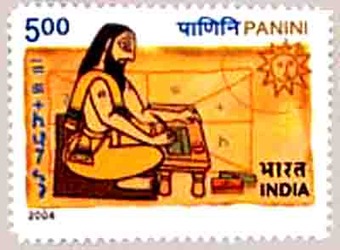
A 2004 Indian stamp honoring Panini, the great Sanskrit grammarian
The scholar Panini standardized the grammar of Vedic Sanskrit to create Classical Sanskrit. With this standardization, Sanskrit became a language of religion and learning.
The
classical period of Sanskrit literature dates to the Gupta period and the
successive pre-Islamic middle kingdoms of India, spanning approximately the 3rd
to 8th centuries CE. Hindu Puranas, a genre of Indian
literature that includes myths and legends, fall into the period of Classical Sanskrit.
Drama
as a distinct genre of Sanskrit literature emerged in the final centuries BCE, influenced
partly by Vedic mythology. Famous Sanskrit dramatists include Shudraka, Bhasa,
Asvaghosa, and Kalidasa; their numerous plays are still available, although
little is known about the authors themselves. Kalidasa’s play, Abhijnanasakuntalam, is generally
regarded as a masterpiece and was among the first Sanskrit works to be
translated into English, as well as numerous other languages.
Works
of Sanskrit literature, such as the Yoga-Sutras of Patanjali, which are still consulted
by practitioners of yoga today, and the Upanishads,
a series of sacred Hindu treatises, were translated into Arabic and Persian. Sanskrit
fairy tales and fables were characterized by ethical reflections and proverbial
philosophy, with a particular style making its way into Persian and Arabic
literature and exerting influence over such famed tales as One Thousand and One Nights, better known in English as Arabian Nights.
Poetry
was also a key feature of this period of the language. Kalidasa was the
foremost Classical Sanskrit poet, with a simple but beautiful style, while
later poetry shifted toward more intricate techniques including stanzas that
read the same backwards and forwards, words that could be split to produce
different meanings, and sophisticated metaphors.
Importance
Sanskrit
is vital to Indian culture because of its extensive use in religious
literature, primarily in Hinduism, and because most modern Indian languages
have been directly derived from, or strongly influenced by, Sanskrit.
Knowledge
of Sanskrit was a marker of social class and educational attainment in ancient
India, and it was taught mainly to members of the higher castes (social groups based on birth
and employment status). In the medieval era, Sanskrit continued to be spoken and
written, particularly by Brahmins (the name for Hindu priests of the highest
caste) for scholarly communication.
Today,
Sanskrit is still used on the Indian Subcontinent. More than 3,000 Sanskrit
works have been composed since India became independent in 1947, while more
than 90 weekly, biweekly, and quarterly publications are published in Sanskrit. Sudharma, a daily newspaper written in
Sanskrit, has been published in India since 1970. Sanskrit is used extensively
in the Carnatic and Hindustani branches of classical music, and it continues to
be used during worship in Hindu temples as well as in Buddhist and Jain
religious practices.
Sanskrit is a major feature of the academic linguistic field of
Indo-European studies, which focuses on both extinct and current Indo-European
languages, and can be studied in major universities around the world.
6.2.4: The Vedas
The Vedas are the oldest texts of the Hindu religion and contain
hymns, myths and rituals that still resonate in India today.
Key Points
-
The Vedas, meaning “knowledge,”
are the oldest texts of Hinduism. - They are derived from the ancient
Indo-Aryan culture of the Indian Subcontinent and began as an oral tradition
that was passed down through generations before finally being written in Vedic
Sanskrit between 1500 and 500 BCE (Before Common Era). - The Vedas are structured in four
different collections containing hymns, poems, prayers, and religious
instruction. - The Indian caste system is based
on a fable from the Vedas about the sacrifice of the deity Purusha.
Key Terms
- Rig Veda
-
The oldest and most important of the four Vedas.
- Caste System
-
An ancient social structure based upon one of the fables in the Vedas, castes persist in modern India.
- Vedas
-
The oldest scriptures of Hinduism, originally passed down orally but then written in Vedic Sanskrit between 1500 and 500 BCE.
- Hinduism
-
A major world religion that began on the Indian Subcontinent.
The
Indo-Aryan Vedas remain the oldest scriptures of Hinduism, which is considered
one of the oldest religions in the world. Vedic ritualism, a composite of ancient
Indo-Aryan and Harappan culture, contributed to the deities and traditions of
Hinduism over time. The Vedas are split into four major texts and contain
hymns, mythological accounts, poems, prayers, and formulas considered sacred to
the Vedic religion.
Structure
of the Vedas
Vedas,
meaning “knowledge,” were written in Vedic Sanskrit between 1500 and
500 BCE in the northwestern region the Indian Subcontinent. The Vedas were
transmitted orally during the course of numerous subsequent generations before
finally being archived in written form. Not much is known about the authors of
the Vedas, as the focus is placed on the ideas found in Vedic tradition rather
than those who originated the ideas. The oldest of the texts is the Rig Veda,
and while it is not possible to establish precise dates for each of the ancient
texts, it is believed the collection was completed by the end of the 2nd millennium
BCE (Before Common Era).
There
are four Indo-Aryan Vedas: the Rig Veda contains hymns about their mythology;
the Sama Veda consists mainly of hymns about religious rituals; the Yajur Veda
contains instructions for religious rituals; and the Atharva Veda consists of
spells against enemies, sorcerers, and diseases. (Depending on the source
consulted, these are spelled, for example, either Rig Veda or Rigveda.)
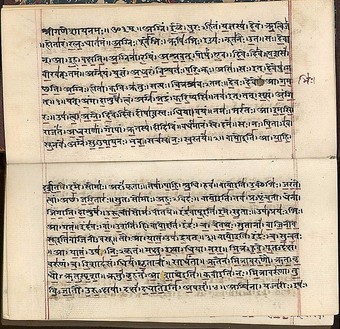
Rigveda Manuscript
A manuscript copy of the Rigveda, the oldest and most important of the four Vedas of the Vedic religion, from the early 19th century.
The
Rig Veda is the largest and considered the most important of the collection,
containing 1,028 hymns divided into 10 books called mandalas. The verses of the
Sam Veda are taken almost completely from the Rig Veda, but arranged
differently so they may be chanted. The Yajur Veda is divided into the White
and Black halves and contains prose commentaries on how religious and
sacrifices should be performed. The Atharva Veda includes charms and magic
incantations written in the style of folklore.
Each
Veda was further divided in two sections: the Brahmanas, instructions for
religious rituals, and the Samhitas, mantras or hymns in praise of various
deities. Modern linguists consider the metrical hymns of the Rigveda Samhita, the
most ancient layer
of text in the Vedas, to have been composed by many authors over several
centuries of oral tradition.
Although
the focus of the Vedas is on the message rather than the messengers, such as
Buddha or Jesus Christ in their respective religions, the Vedic religion still
held gods in high regard.
Vedic
Religion
The
Aryan pantheon of gods is described in great detail in the Rig Veda. However,
the religious practices and deities are not uniformly consistent in these
sacred texts, probably because the Aryans themselves were not a homogenous
group. While spreading through the Indian Subcontinent, it is probable that
their initial religious beliefs and practices were shaped by the absorption of
local religious traditions.
According
to the hymns of the Rig Veda, the most important deities were Agni, the god of
Fire, intermediary between the gods and humans; Indra, the god of Heavens and
War, protector of the Aryans against their enemies; Surya, the Sun god; Vayu,
the god of Wind; and Prthivi, the goddess of Earth.
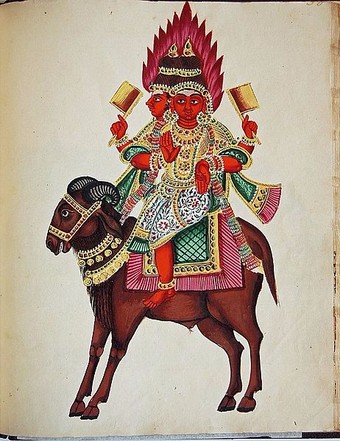
Agni, God of Fire
Agni, the Indian God of Fire from the ancient Vedic religion, shown riding a ram.
Vedas and
Castes
The Caste System, or groups based on birth or employment status, has been part of the
social fabric of the Indian Subcontinent since ancient times. The castes are
thought to have derived from a hymn found in the Vedas to the deity Purusha,
who is believed to have been sacrificed by the other gods. Afterward Purusha’s
mind became the Moon, his eyes became the Sun, his head the Sky, and his feet
the Earth.
The
passage describing the classes of people derived from the sacrifice of Purusha
is the first indication of a caste system. The Brahmins, or priests, came from
Purusha’s mouth; the Kshatriyas, or warrior rulers, came from Purusha’s arms;
the Vaishyas, or commoners such as landowners and merchants, came from Purusha’s
thighs; and the Shudras, or laborers and servants, came from Purusha’s feet.
Today
the castes still exist in the form of varna, or class system, based on the
original four castes described in the Vedas. A fifth group known as Dalits,
historically excluded from the varna system, are ostracized and called
untouchables. The caste system as it exists today is thought to be a product of
developments following the collapse of British colonial rule in India. The system
is frowned upon by many people in Indian society and was a focus of social justice
campaigns during the 20th century by prominent progressive activists such as B.
R. Ambedkar, an architect of the Indian Constitution, and Mahatma Gandhi, the revered
leader of the nonviolent Indian independence movement.
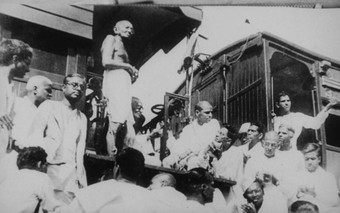
Gandhi at Madras, 1933
Indian independence leader Mahatma Gandhi visits Madras, now Chennai, on a tour of India in 1933. During his appearances Gandhi frequently spoke out against the discrimination of the Indian caste system.
6.3: Religion in the Indian Subcontinent
6.3.1: The Rise of Hinduism
Hinduism evolved as a synthesis of cultures and traditions,
including the Indo-Aryan Vedic religion.
Learning Objective
Explain the evolution of hinduism
Key Points
- The Vedic religion was influenced
by local cultures and traditions adopted by Indo-Aryans as
they spread throughout India. Vedic ritualism heavily influenced the rise of
Hinduism, which rose to prominence after c. 400 BCE. - The Vedas—
the oldest texts of
the Hindu religion—describe deities,
mythology, and instructions for religious rituals. -
The Upanishads are
a collection of Vedic texts particularly important to Hinduism that
contain revealed truths concerning the nature of ultimate reality, and
describing the character and form of human salvation. -
During the 14th and 15th centuries, the Hindu Vijayanagar Empire served as a barrier against Muslim invasion, fostering a reconstruction of Hindu life and administration.
The Hindu Maratha Confederacy rose to power in the 18th century and eventually overthrew Muslim rule in India.
Key Terms
- moksha
-
The character and
form of human salvation, as described in the Upanishads. - Sramana
-
Meaning “seeker,” Sramana refers to several Indian religious movements that existed alongside the Vedic religion, the historical predecessor of modern Hinduism.
- brahman
-
The nature of ultimate reality, as described in the Upanishads.
- Upanishads
-
A collection of Vedic texts that contain the earliest emergence of some of the central religious concepts of Hinduism, Buddhism, and Jainism.
Hinduism
is considered one of the oldest religions in the world. Western scholars regard
Hinduism as a synthesis, or fusion, of various Indian cultures and traditions,
with diverse roots and no stated founder. This synthesis is believed to
have developed after Vedic times, between 500 BCE and 300 CE. However, Vedic ritualism, a composite of Indo-Aryan and Harappan culture,
contributed to the deities and traditions of Hinduism. The Indo-Aryan Vedas
remain the oldest scriptures of the Hindu religion, which has grown culturally
and geographically through modern times to become one of the world’s four major
religions.
The Vedas
Vedas,
meaning “knowledge,” were written in Vedic Sanskrit between 1500 and
500 BCE in the northwestern region of the Indian Subcontinent. There are four
Indo-Aryan Vedas: the Rig Veda contains hymns about mythology; the Sama Veda
consists mainly of hymns about religious rituals; the Yajur Veda contains
instructions for religious rituals; and the Atharva Veda consists of spells
against enemies, sorcerers and diseases. (Depending on the source consulted,
these are spelled, for example, either Sama Veda or Samaveda.) The Rig Veda is
the largest and considered the most important of the collection, containing
1,028 hymns divided into ten books, called mandalas.
The
Aryan pantheon of gods is described in great detail in the Rig Veda. However,
the religious practices and deities are not uniformly consistent in these
sacred texts, probably because the Aryans themselves were not a homogenous
group. While spreading through the Indian subcontinent, it is probable their
initial religious beliefs and practices were shaped by the absorption of local
religious traditions.
According
to the hymns of the Rig Veda, the most important deities were Agni, the god of
Fire, and the intermediary between the gods and humans; Indra, the god of Heavens and
War, protector of the Aryans against their enemies; Surya, the Sun god; Vayu,
the god of Wind; and Prthivi, the goddess of Earth.
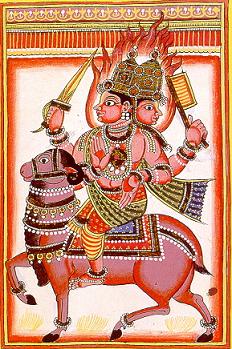
Modern Hindu representation of Agni, god of fire
The Rig Veda describes the varied deities of Vedic religion. These gods persisted as Vedic religion was assimilated into Hinduism.
The
Upanishads
The
Upanishads are a collection of Vedic texts that contain the earliest emergence
of some of the central religious concepts of Hinduism, Buddhism, and Jainism. Also known as Vedanta,
“the end of the Veda,” the collection is one of the sacred texts of
Hinduism thought to contain revealed truths concerning the nature of ultimate
reality, or brahman, and describing the character and form of human salvation, called
moksha. The Upanishads are found in the conclusion of the commentaries on the Vedas, and have been passed down by oral
tradition.
Hindu Synthesis
Sramana,
meaning “seeker,” refers to several Indian religious movements, including Buddhism
and Jainism, that existed alongside the Vedic religion—the historical
predecessor of modern Hinduism. The Sramana traditions drove the so-called Hindu
synthesis after the Vedic period that spread to southern Indian and parts of
Southeast Asia. As it spread, this new Hinduism assimilated popular non-Vedic
gods and other traditions from local cultures, and integrated societal
divisions, called the caste system. It is also thought to
have included both Buddhist and Sramana influences.
Splinter and Rise of Hinduism
During
the reign of the Gupta Empire (between 320-550 CE), which included the period
known as the Golden Age of India, the first known stone and cave temples
dedicated to Hindu deities were built. After the Gupta period, central power disintegrated
and religion became regionalized to an extent, with variants arising within Hinduism
and competing with each other, as well as sects of Buddhism and Jainism. Over
time, Buddhism declined but some of its practices were integrated into
Hinduism, with large Hindu temples being built in South and Southeast Asia.
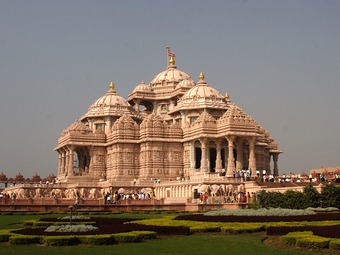
The Swaminarayan Akshardham Temple in Delhi, the world’s largest Hindu temple
Hinduism evolved as a combination of various cultures and traditions, including Vedic religion and the Upanishads.
The
Hindu religion maintained its presence and continued to grow despite a long period
of Muslim rule in India, from 1200-1750 CE, during which Hindus endured violence
as Islam grew to become what is now the second largest religion in India,
behind Hinduism. Akbar I, emperor of the ruling Mughal Dynasty in India from
1556-1605 CE, ended official persecution of non-Muslims and recognized Hinduism,
protected Hindu temples, and abolished discriminatory taxes against Hindus.
Hindu Prominence
During
the 14th and 15th centuries, the Hindu Vijayanagar Empire had arisen and served
as a barrier against invasion by Muslim rulers to the north, fostering a
reconstruction of Hindu life and administration. Vidyaranya, a minister and
mentor to three generations of kings in the Vijayanagar Empire beginning around
1336, helped spread the historical and cultural influence of Shankara—an Indian
philosopher of the 8th century CE credited with unifying and establishing the
main currents of thought in Hinduism.
The
Hindu Maratha Confederacy rose to power in the 18th century and eventually
overthrew Muslim rule in India. In the 19th century, the Indian subcontinent became
a western colony during the period of the British Raj (the name of the British
ruling government) beginning in 1858.
Through
the period of the Raj, until its end in 1947, there was a Hindu resurgence, known
as the Bengali Renaissance, in the Bengal region of India. It included a
cultural, social, intellectual, and artistic movement. Indology, an academic study
of Indian culture, was also established in the 19th century, and spread
knowledge of Vedic philosophy and literature and promoted western interest in
Hinduism.
In
the 20th century, Hinduism gained prominence as a political force and source of
national identity in India. According to the 2011 census, Hindus account for
almost 80% of India’s population of 1.21 billion people, with 960
million practitioners. Other nations with large Hindu populations include Nepal, with 23 million followers, and Bangladesh, with 15 million. Hinduism counts over
1 billion adherents across the globe, or approximately 15% of the world’s
population.

Singapore Diwali Decorations
Diwali decorations in Little India are part of an annual Hindu celebration in Singapore, where there are over 260,000 Hindus.
6.3.2: The Sramana Movement
Sramana broke with Vedic Hinduism over the
authority of the Brahmins and the need to follow ascetic lives.
Learning Objective
Understand the Sramana movement
Key Points
-
Sramana was an ancient Indian
religious movement with origins in the Vedic religion. However, it took a divergent
path, rejecting Vedic Hindu ritualism and the authority of the Brahmins—the
traditional priests of the Hindu religion. - Sramanas were those who practiced an ascetic, or
strict and self-denying, lifestyle in pursuit of spiritual liberation. They are commonly known as monks. - The Sramana movement gave rise to Jainism and Buddhism.
Key Terms
- Sramana
-
An ancient Indian religious movement that began as an offshoot of the Vedic religion and focused on ascetic lifestyle and principles.
- Brahmin
-
A member of a caste in Vedic Hinduism, consisting of priests and teachers who are held as intermediaries between deities and followers, and who are considered the protectors of the sacred learning found in the Vedas.
- Sramanas
-
Sramana followers who renounced married and domestic life, and adopted an ascetic path. The Sramanas rejected the authority of the Brahmins.
- Vedic Religion
-
The historical predecessor of modern Hinduism. The Vedas are the oldest scriptures in the Hindu religion.
- ascetic
-
A person who practices severe self-discipline and abstention from worldly pleasures as a way of seeking spiritual enlightenment and freedom.
Sramana
was an ancient Indian religious movement that began as an offshoot of the Vedic
religion and gave rise to other similar but varying movements, including
Buddhism and Jainism. Sramana, meaning “seeker,” was a tradition that began around
800-600 BCE when new philosophical groups, who believed in a more austere path to spiritual
freedom, rejected the authority of the Brahmins (the priests of Vedic Hinduism). Modern Hinduism can be regarded as a
combination of Vedic and Sramana traditions; it is substantially influenced
by both.
Vedic Roots
The
Vedic Religion was the historical predecessor of modern Hinduism. The
Vedic Period refers to the time period from approximately 1750-500 BCE, during
which Indo-Aryans settled into northern India, bringing with them specific
religious traditions. Most history of this period is derived from the Vedas, the
oldest scriptures in the Hindu religion. Vedas, meaning “knowledge,”
were composed by the Aryans in Vedic Sanskrit between 1500 and 500 BCE, in the northwestern
region the Indian subcontinent.
There
are four Indo-Aryan Vedas: the Rig Veda contains hymns about their mythology;
the Sama Veda consists mainly of hymns about religious rituals; the Yajur Veda
contains instructions for religious rituals; and the Atharva Veda consists of
spells against enemies, sorcerers, and diseases. (Depending on the source
consulted, these are spelled, for example, either Rig Veda or Rigveda.)
Sramana Origins
Several
Sramana movements are known to have existed in India before the 6th century
BCE. Sramana existed in parallel to,
but separate from, Vedic Hinduism. The dominant Vedic ritualism contrasted with
the beliefs of the Sramanas followers who renounced married and domestic life
and adopted an ascetic path, one of severe self-discipline and abstention from
all indulgence, in order to achieve spiritual liberation. The Sramanas rejected the
authority of the Brahmins, who were considered the protectors of the sacred
learning found in the Vedas.
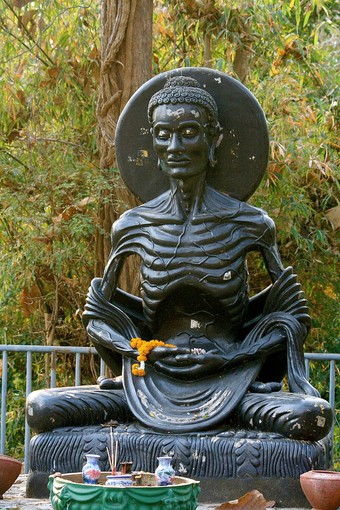
Emaciated Fasting Buddha
Buddha practiced severe asceticism before his enlightenment and recommended a non-ascetic middle way.
Brahmin
is a caste, or social group, in Vedic Hinduism consisting of priests and
teachers who are held as intermediaries between deities and followers. Brahmins
are traditionally responsible for religious rituals in temples, and for reciting
hymns and prayers during rite of passage rituals, such as weddings.
In
India, Sramana originally referred to any ascetic, recluse, or religious
practitioner who renounced secular life and society in order to focus solely on finding religious
truth. Sramana evolved in India over two phases: the Paccekabuddha, the tradition of the individual ascetic, the “lone
Buddha” who leaves the world behind; and the Savaka, the phase of disciples, or
those who gather together as a community, such as a sect of monks.
Sramana Traditions
A “tradition” is a belief or behavior passed down within a group or society, with symbolic
meaning or special significance. Sramana traditions drew upon established Brahmin concepts to
formulate their own doctrines.
The
Sramana traditions subscribe to diverse philosophies, and at times significantly disagree
with each other, as well as with orthodox Hinduism and its six schools of Hindu philosophy.
The differences range from a belief that every individual has a soul, to the
assertion that there is no soul. In terms of lifestyle, Sramana traditions include
a wide range of beliefs that can vary, from vegetarianism to meat eating, and from family
life to extreme asceticism denying all worldly pleasures.
The
varied Sramana movements arose in the same circles of ancient India that led to
the development of Yogic practices, which include the Hindu philosophy of
following a course of physical and mental discipline in order to attain liberation from
the material world, and a union between the self and a supreme being or principle.
The
Sramana traditions drove the so-called Hindu synthesis after the Vedic period, which spread to southern Indian and parts of Southeast Asia. As it spread, this
new Hinduism assimilated popular non-Vedic gods and other traditions from local
cultures, as well as the integrated societal divisions, called the caste system.
Sramaṇa traditions later gave rise to Yoga, Jainism, Buddhism, and
some schools of Hinduism. They also led to popular concepts in all major Indian religions, such as saṃsāra, the cycle of birth and death, and moksha, liberation from that cycle.
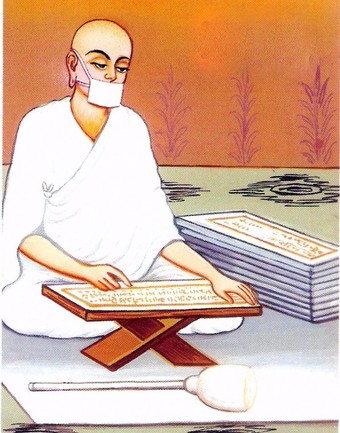
Jain Monk in Meditation
An image of a Jain monk, one of the practitioners of the varied Sramana traditions.
6.3.3: Buddhism
After attaining Enlightenment, Siddhartha Gautama became known
as the Buddha, and taught a Middle Way that became a major world religion, known as Buddhism.
Learning Objective
Understand the development of Buddhism as a major world religion
Key Points
-
Sramanas were those who practiced an
ascetic, or strict and self-denying, lifestyle in pursuit of spiritual liberation. They are commonly known as monks. - The Sramana movement gave rise to Buddhism,
a non-theistic religion that encompasses a variety of traditions, beliefs, and
practices, and arose when Siddhartha Gautama began following Sramana traditions
in the 5th century BCE. - Following his “Enlightenment,” Siddhartha became known as Buddha, or “Awakened One.” He began teaching a
Middle Way to spiritual Nirvana, a release from all earthly burdens. - Buddhism has spread to become one
of the world’s great religions, with an estimated 488 million followers.
Key Terms
- Noble Eightfold Path
-
The eight concepts taught by Buddha as the means to achieving Nirvana.
- Siddhartha Gautama
-
An aristocratic young man who gave up worldly comforts to follow Sramana, then attained Enlightenment and became known as the Buddha, teaching a Middle Way toward spiritual Nirvana.
- Nirvana
-
A sublime state
that marks the release from the cycle of rebirths, known in the Sramana tradition as samsara. - Sramana
-
An offshoot of the Vedic religion that promoted an ascetic lifestyle; Sramana gave rise to Buddhism and other similar traditions.
Buddhism
arose between 500-300 BCE, when Siddhartha Gautama, a young man from an
aristocratic family, left behind his worldly comforts to
seek spiritual enlightenment. He became a teacher commonly known as the Buddha,
meaning “the awakened one,” and Buddhism spread to become a non-theistic
religion that encompasses a variety of traditions, beliefs, and practices
largely based on his teachings.
Sramana Origins
Buddhism
is based on an ancient Indian religious philosophy called Sramana, which began
as an offshoot of the Vedic religion. Several Sramana movements are known to
have existed in India before the 6th century BCE. Sramana existed in parallel to, but separate
from, Vedic Hinduism, which followed the teachings and rituals found in the
Vedas, the most ancient texts of the Vedic religion. Sramana, meaning “seeker,” was a tradition that began when new philosophical groups who believed in a more
austere path to spiritual freedom rejected the authority of the Vedas and the Brahmins,
the priests of Vedic Hinduism, around 800-600 BCE.
Sramana
promoted spiritual concepts that became popular in all major Indian religions,
such as saṃsāra, the cycle of
birth and death, and moksha, liberation from that cycle. The
Sramanas renounced married and domestic life, and adopted an ascetic path—
one
of severe self-discipline and abstention from all indulgence—in order to achieve
spiritual liberation. Sramaṇa traditions (or its religious and moral practices) later gave rise to varying schools of
Hinduism, as well as Yoga, Jainism, and Buddhism.
Origins of
Buddhism
Early
texts suggest Siddhartha Gautama was born into the Shakya Clan, a community on
the eastern edge of the Indian subcontinent in the 5th century BCE. His father
was an elected chieftain, or oligarch, of the small republic. Gautama is thought
to have been born in modern-day Nepal, and raised in the Shakya capital of
Kapilvastu, which may have been in Nepal or India. Most scholars agree that he
taught and founded a monastic order during the reign of the Magadha Empire. In
addition to the Vedic Brahmins, the Buddha’s lifetime coincided with the flourishing
of influential Sramana schools of thought, including Jainism.
Buddhist
teachings explain that Siddhartha was a young man from a respected family, who
renounced his family and left his father’s palace at age 29 in search of truth and
enlightenment through Sramana. Siddhartha began this quest through a period of
starvation and, according to legend, grew so thin he could feel his hands if he
placed one on his back and the other on his stomach. This explains statues that
depict Buddha as thin and withered, rather than the better known depiction of him
seated with a large belly.
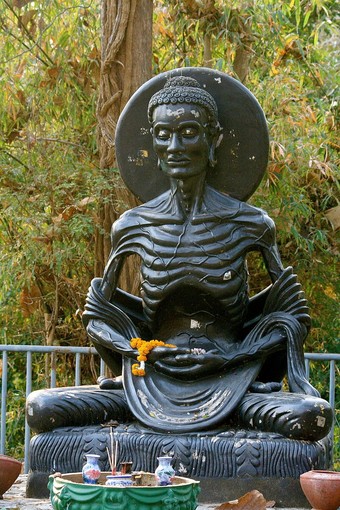
Emaciated Fasting Buddha
This statue in Chiang Mai, Thailand, depicts the Buddha practicing severe asceticism before his Enlightenment.
Buddha lived as a Sramana ascetic for approximately six years until he had an “awakening”
in a place called Bodh Gaya, in the Gaya district of the modern Indian state of
Bihar. Sitting under what became known as the Bodhi Tree, Siddhartha discovered
what Buddhists call the Noble Eightfold Path, and attained Buddhatva, or
Enlightenment, which is said to be a state of being completely free of lust
(raga), hatred (dosa), and delusion (moha).
Siddhartha,
thereafter known as Buddha, or “awakened one,” was recognized by his followers,
called Buddhists, as an enlightened teacher. He taught what he called the
Middle Way or Middle Path, the character of the Noble Eightfold Path. This includes
eight concepts to be sought after: right view, right resolve, right speech,
right conduct, right livelihood, right effort, right mindfulness, and right
samadhi (the state of intense concentration brought on through meditation).
His
insights were intended to help sentient beings end their suffering through the
elimination of ignorance and craving. This could be achieved through understanding the noble path, which
is the way to achieve the sublime state of Nirvana. The literal meaning of
Nirvana in the Sanskrit language is “blowing out” or “quenching,” and is the
ultimate spiritual goal of Buddhism. It marks the release from the cycle of
rebirths, known in the Sramana tradition as samsara.
Another
important Buddhist concept is Bodhisattva, a Sanskrit word for anyone who has been
motivated by great compassion and a wish to attain buddhahood for the benefit
of all sentient beings—those who have a conscious awareness of the self but are
in contrast with buddhahood. Sentient beings are characteristically not yet
enlightened and are thus confined to the death, rebirth and dukkha (suffering) found in the cycle of samsara. Bodhisattvas, therefore, are those who
have set themselves on the path toward enlightenment and hope to benefit others
through their journey. Depictions of the bodhisattva path are a popular subject
in Buddhist art.
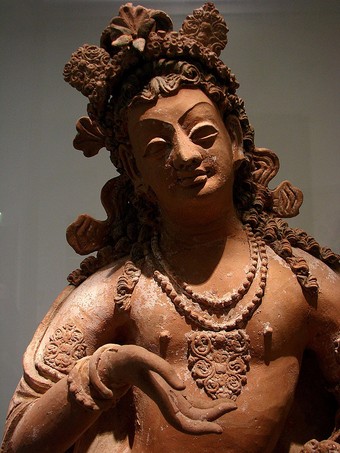
Bodhisattva
Clay sculpture of a bodhisattva, Afghanistan, 7th century.
Rise of Buddhism
Buddha
is thought to have died around 483 BCE, after 45 years of travel and teaching.
Buddhists believe he passed into a state of Nirvana. Small communities of
monks and nuns, known as bhikkus, sprung up along the routes Buddha traveled. Buddhism was overshadowed by the more dominant Hindu religion, but this began to change
in the 3rd century BCE; this was when one of the Indian subcontinent’s great
rulers, Ashoka I of the Maurya Empire, renounced wars, despite having waged war
to build his own kingdom. In a major break from others rulers of the time, he converted
to Buddhism.
Ashoka
promoted the religion’s expansion by deploying monks to spread Buddha’s
teaching. This began a wave of conversion throughout India as well as in surrounding
nations, such as Nepal, Tibet, and Burma, but also further afield in Asia, including in China and Japan. Over time Buddhism grew, as greater numbers of people
became aware of its teachings, including those in western nations, eventually
becoming one of the major religions practiced around the world.
Today, Buddhism is practiced by an estimated 488 million people. China
is the nation with the largest number of Buddhists, approximately 244 million
followers, or more than 18% of its total population. Other countries that have
a large number of Buddhists among their populations include Myanmar with 48.4
million, Japan with 45.8 million, Sri Lanka with 14.2 million, Cambodia with
13.7 million, South Korea with 11 million, Thailand, Laos, Singapore, Taiwan,
and Nepal. The United States is home to an estimated 1.2 million Buddhists, or
1.2% of the American population.
6.3.4: Jainism
Jainism is a pre-Buddhist religion with roots in the Sramana
tradition. It focuses on karma.
Learning Objective
Understand the origins and principles of Jainism
Key Points
-
Sramanas were those who practiced an
ascetic, or strict and self-denying, lifestyle in pursuit of spiritual liberation. They are commonly known as monks. - The Sramana movement gave rise to Jainism, which is considered an
independent, pre-Buddhist religion with possible roots in the Indus Valley
Civilization. - The predominance of karma is one of the key features of Jainism. Karma is the sum of a person’s actions in this and previous lives; it determines his or her fate in future existences.
Key Terms
- Jainism
-
An Indian
religion that prescribes a path of non-violence toward all living beings, and
emphasizes spiritual independence and equality between all forms of life. - ascetic
-
A person who
practices severe self-discipline and abstention from worldly pleasures in order to attain a higher level of spirituality. - karma
-
The principle of
causality in which intent and actions of an individual influence the future of
that person; this is a key concept in Jainism, as well as in Hinduism and
Buddhism. - saṃsāra
-
The repeating
cycle of birth, life, and death (reincarnation) within Jainism, Hinduism, and
Buddhism.
Jainism,
one of the world’s major religions, is believed to have roots in the Indus
Valley Civilization, and follows aspects of the Sramana traditions of
asceticism—self-denial and control in order to achieve a higher level of
spirituality. Although Jainism is considered pre-Buddhist, the two religions
have a link through a focus on karma—the concept that good deeds in one life
will lead to a better existence in the next life. The ultimate aim of Jainism
is to achieve liberation of the soul.
Sramana Origins
Jainism
is based on an ancient Indian religious philosophy called Sramana, which began
as an offshoot of the Vedic religion. Several Sramana movements are known to
have existed in India before the 6th century BCE. Sramana existed in parallel to, but separate
from, Vedic Hinduism, which followed the teachings and rituals found in the
Vedas, the most ancient texts of the Vedic religion. Sramana, meaning “seeker,” was a tradition that began around 800-600 BCE, when new philosophical groups, who believed in a more
austere path to spiritual freedom, rejected the authority of the Vedas and the Brahmins (the priests of Vedic Hinduism).
Sramana
promoted spiritual concepts that became popular in all major Indian religions,
such as saṃsāra, the cycle of
birth and death, and moksha, liberation from that cycle. The
Sramanas renounced married and domestic life and adopted an ascetic path (one
of severe self-discipline and abstention from all indulgence) in order to achieve
spiritual liberation. Sramaṇa traditions (or religious and moral practices) later gave rise to varying schools of
Hinduism, as well as Yoga, Buddhism, and Jainism.
Origins of
Jainism
Jainism
is considered an independent, pre-Buddhist religion that began c. 700 BCE, although its origins are
disputed. Some scholars claim Jainism has its roots in the Indus Valley
Civilization, reflecting native spirituality prior to the Indo-Aryan migration
into India.
Various seals from Indus Valley Civilizations
bear resemblance to Rishabha, the first Jain as the visual representation of
Vishnu. Many relics depict Jain symbols, including standing nude male figures,
images with serpent-heads, and the bull symbol of Vrshabadeva. However, other
scholars believe the Sramana traditions were separate and contemporaneous with
Indo-Aryan religious practices of the historical Vedic religion.
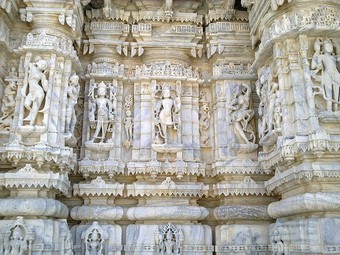
An Elaborate Mirpur Jain Temple Wall
The Jain Temple in Mirpur, India, was built c. 800 CE.
Jainism Beliefs
The
distinguishing features of Jain philosophy are its belief in the independent
existence of soul and matter; the denial of a creative and omnipotent God, combined with a belief in an eternal universe; and a strong
emphasis on non-violence, morality, and ethics. The word Jain derives from the
Sanskrit word jina, meaning conqueror, and the ultimate aim of Jain life is to
achieve liberation of the soul.
The predominance
of karma is one of the key features of
Jainism. Karma is the sum of a person’s actions in this and previous lives that
determine his or her fate in future existences. A Sanskrit word, karma means action,
word, or deed. Its focus is on the spiritual principle of cause and effect, with
individual actions influencing individual effects. Good intent and good deeds
contribute to good karma and future happiness, while bad intent and deeds
produce bad karma and future suffering. Karma is a concept associated with
rebirth, or the idea that death is the beginning of a new existence. This idea also
appears in other Asian religions, including Buddhism.
The
motto of Jainism is Parasparopagraho Jivanam, meaning “the function of souls is
to help one another.” This is associated with the idea of good deeds, and is incorporated
into the main principles of Jainism: ahimsa, non-violence; anekantavada,
non-absolutism; and aparigraha, non-possessiveness or non-attachment. Followers
take five main vows that include ahimsa and aparigraha, as well as satya, not
lying; asteya, not stealing; and brahmacharya, chastity. Jain monks and nuns
adhere to these vows absolutely, placing Jainism squarely in the ascetic and
self-discipline traditions of Sramana.
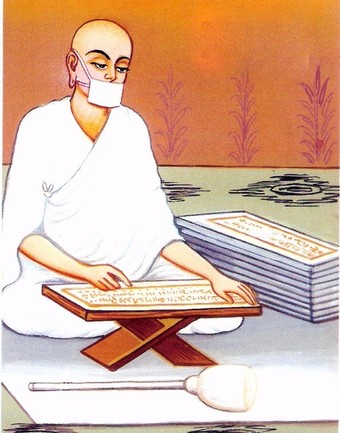
Jain Monk
An image of a Jain monk meditating over religious texts.
Jainism Followers
The
majority of Jains live in India, which counts between 4 and 6 million
followers. Some of the largest Jain communities outside India are in the United
States, which has more than 79,000 followers; Kenya, which has nearly 69,000
adherents; the United Kingdom, which counts nearly 17,000 followers; and Canada,
with approximately 12,000 followers. Other countries with notable Jain
populations include Tanzania, Nepal, Uganda, Burma, Malaysia, South Africa,
Fiji, Australia, and Japan.
Contemporary
Jainism is divided into two major schools, or sects, called Digambara and
Svetambara. The Svetambara, meaning “white clad,” describes its ascetic
adherents’ practice of wearing white clothes, while the monks of the “sky clad” Digambara do not wear clothing at all, a practice upon which they disagree.
The most important religious festival of Jainism is Mahavir Jayanti,
which celebrates the birth of Mahavira—the 24th and last Tirthankara, or
teaching god. Other important festivals include Diwali, marking the Nirvana, or
liberation, of Mahavira’s soul; and the holy event of Paryushana, also known as
Das Lakshana, which is a period of between eight and ten days in August or
September of fasting, prayer, and meditation.
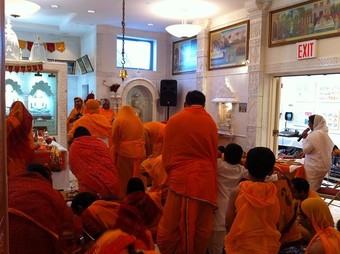
Paryushana Celebrations
Followers of Jainism celebrate Paryushana at the Jain Center of America in New York City.
6.4: The Persian Empire
6.4.1: The Achaemenid Empire
Under Cyrus the Great and Darius the Great, the Achaemenid Empire became the first global empire.
Learning Objective
Discuss the Achaemenid as the first global empire
Key Points
- Around 550 BCE, Cyrus
the Great (Cyrus
II) conquered the Median
Empire and
started the expansion of the Achaemenid Empire, assimilating the neighboring
Lydian and Neo-Babylonian empires. - Cyrus the Great was succeeded by
his son Cambryses II in 530 BCE and then the usurper Gaumata, and finally by Darius
the Great in
522 BCE. - By the time of Darius the Great
and his son, Xerxes, the Achaemenid Empire had expanded to include Mesopotamia,
Egypt, Anatolia, the Southern Caucasus, Macedonia, the western Indus basin, as well as parts of Central Asia, northern Arabia and northern Libya. - At its height around 475 BCE, the
Achaemenid Empire ruled over 44% of the world’s population, the highest figure
for any empire in history.
Key Terms
- Median Empire
-
One of the four
major powers of the ancient Near East (with Babylonia, Lydia, and Egypt), until it was conquered by Cyrus the Great in 550 BCE. - Pasargadae
-
The capital of
the Achaemenid Empire under Cyrus the Great. - Cyrus the Great
-
Cyrus II of
Persia, also known as Cyrus the Great, created the largest empire the world had
seen. - Darius the Great
-
The third king of
the Persian Achaemenid Empire, who ruled at its peak from c. 522-486 BCE.
The
Achaemenid Empire, c. 550-330 BCE, or First Persian Empire,
was founded in the 6th century BCE by Cyrus the Great, in Western and Central
Asia. The dynasty drew its name from Achaemenes, who, from 705-675 BCE, ruled
Persis, which was land bounded on the west by the Tigris River and on the south by the
Persian Gulf. It was the first centralized nation-state, and during expansion in
approximately 550-500 BCE, it became the first global empire and eventually ruled
over significant portions of the ancient world.
Empire Beginnings
By
the 7th century BCE, a group of ancient Iranian people had established the
Median Empire, a vassal state under the Assyrian Empire that later tried to gain its
independence in the 8th century BCE. After Assyria fell in 605 BCE, Cyaxares,
king of the Medes, extended his rule west across Iran.
Around 550 BCE, Cyrus II of Persia, who became known as Cyrus the Great,
rose in rebellion against the Median Empire, eventually conquering the Medes to
create the first Persian Empire, also known as the Achaemenid Empire. Cyrus utilized
his tactical genius, as well as his understanding of the socio-political
conditions governing his territories, to eventually assimilate the neighboring
Lydian and Neo-Babylonian empires into the new Persian Empire.
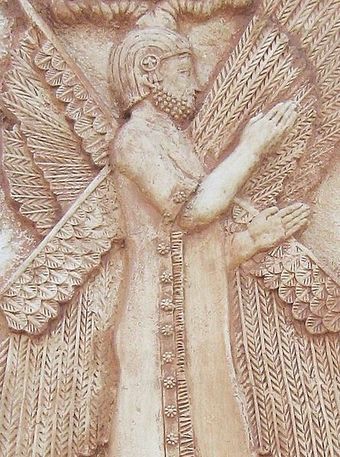
Relief of Cyrus the Great
Cyrus II of Persia,
better known as Cyrus the Great, was the founder of the Achaemenid Empire.
Under his rule, the empire assimilated all the civilized states of the ancient
Near East, and eventually conquered most of Southwest Asia and much of Central
Asia and the Caucasus.
Achaemenid
Expansion
The
empire was ruled by a series of monarchs who joined its disparate tribes by
constructing a complex network of roads. The unified form of the empire came in
the form of a central administration around the city of Pasargadae, which was erected by Cyrus
c. 550 BCE. After his death in 530 BCE, Cyrus was succeeded by his son
Cambyses II, who conquered Egypt, Nubia, and Cyrenaica in 525 BCE; he died
in 522 BCE during a revolt.
During
the king’s long absence during his expansion campaign, a Zoarastrian priest, named Guamata, staged a coup by impersonating Cambryses II’s
younger brother, Bardiya, and seized the throne. Yet in 522 BCE, Darius I, also
known as Darius the Great, overthrew Gaumata and solidified control of the
territories of the Achaemenid Empire, beginning what would be a historic
consolidation of lands.
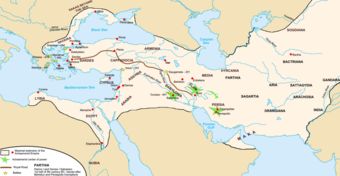
Achaemenid Empire in the time of Darius and Xerxes
At its height, the
Achaemenid Empire ruled over 44% of the world’s population, the highest figure
for any empire in history.
Between
c. 500-400 BCE, Darius the Great and his son, Xerxe I, ruled the Persian Plateau
and all of the territories formerly held by the Assyrian Empire, including
Mesopotamia, the Levant, and Cyprus. It eventually came
to control Egypt, as well. This expansion continued even further afield with
Anatolia and the Armenian Plateau, much of the Southern Caucasus, Macedonia,
parts of Greece and Thrace, Central Asia as far as the Aral Sea, the Oxus and
Jaxartes areas, the Hindu Kush and the western Indus basin, and
parts of northern Arabia and northern Libya.
This
unprecedented area of control under a single ruler stretched from the Indus
Valley in the east to Thrace and Macedon on the northeastern border of
Greece. At its height, the Achaemenid Empire ruled over 44% of the world’s
population, the highest such figure for any empire in history.
6.4.2: Government and Trade in the Achaemenid Empire
Emperors Cyrus II and Darius I created a centralized government
and extensive trade network in the Achaemenid Empire.
Learning Objective
Discuss how the central government provided cultural and economic reform
Key Points
- Cyrus
the Great maintained
control over a vast empire by installing regional governors, called satraps, to
rule individual provinces. -
When Darius
the Great ascended
the throne in 522 BCE, he organized a new uniform monetary system and
established Aramaic as
the official language of the empire. - Trade infrastructure facilitated
the exchange of commodities in the far reaches of the empire, including the Royal
Road, standardized language, and a postal service. - Tariffs on trade from the
territories were one of the empire’s main sources of revenue, in addition to agriculture and tribute.
Key Terms
- Cyrus Cylinder
-
An ancient clay artifact that has been called the oldest-known charter of human rights.
- Behistun
Inscription -
An inscription carved in a cliff face of Mount Behistrun in Iran; it provided a key to deciphering cuneiform script.
- satrap
-
The governor of a province in the ancient Median and Achaemenid (Persian) Empires.
- satrapy
-
The territory under the rule of a satrap.
The
Achaemenid Empire reached enormous size under the leadership of Cyrus II of
Persia (576-530 BCE), commonly known as Cyrus the Great, who created a multi-state
empire. Called Cyrus the Elder by the Greeks, he founded an empire initially
comprising all the previous civilized states of the ancient Near East and eventually
most of Southwest and Central Asia and the Caucus region, stretching from the
Mediterranean Sea to the Indus River. Control of this large territory involved a
centralized government, territorial monarchs who served as proxy rulers for the
emperor, and an extensive system of commerce and trade.
Government
Organization
Cyrus,
whose rule lasted between 29 and 31 years, until his death in battle in 530 BCE, controlled the vast Achaemenid Empire through the use of regional
monarchs, called satrap, who each oversaw a territory called
a satrapy. The
basic rule of governance was based upon the loyalty and obedience of the satrapy to the central power, the king,
and compliance with tax laws. Cyrus also connected the various regions of the
empire through an innovative postal system that made use of an extensive
roadway and relay stations.
Cyrus
the Great was recognized for achievements in human rights and politics, having
influenced both Eastern and Western Civilization. The ancient Babylonians
called him “The Liberator,” while the modern nation of Iran calls Cyrus its “father.”
Cyrus
Cylinder
The
Cyrus Cylinder is an ancient clay artifact, now broken into several fragments, that
has been called the oldest-known charter of universal human rights and a symbol
of his humanitarian rule.
The
cylinder dates from the 6th century BCE, and was discovered in the ruins of
Babylon in Mesopotamia, now Iraq, in 1879. In addition to describing the
genealogy of Cyrus, the declaration in Akkadian cuneiform script on the
cylinder is considered by many Biblical scholars to be evidence of Cyrus’s policy
of repatriation of the Jewish people following their captivity in Babylon.
The
historical nature of the cylinder has been debated, with some scholars arguing
that Cyrus did not make a specific decree, but rather that the cylinder
articulated his general policy allowing exiles to return to their homelands and
rebuild their temples.
In fact, the policies of Cyrus with respect to treatment
of minority religions were well documented in Babylonian texts, as well as in Jewish sources. Cyrus was known to have an overall attitude of religious
tolerance throughout the empire, although it has been debated whether this was
by his own implementation or a continuation of Babylonian and Assyrian
policies.
Darius Improvements
When
Darius I (550-486 BCE), also known as Darius the Great, ascended the throne of
the Achaemenid Empire in 522 BCE, he established Aramaic as the official
language and devised a codification of laws for Egypt. Darius also sponsored work
on construction projects throughout the empire, focusing on improvement of the cities
of Susa, Pasargadae, Persepolis, Babylon, and
various municipalities in Egypt.
When
Darius moved his capital from Pasargadae to Persepolis, he revolutionized the
economy by placing it on a silver and gold coinage and introducing a regulated
and sustainable tax system. This structure precisely tailored the taxes of each satrapy
based on its projected productivity and economic potential. For example,
Babylon was assessed for the highest amount of silver taxes, while Egypt owed grain
in addition to silver taxes.
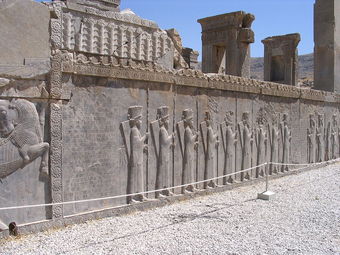
Persian reliefs in the city of Persepolis
Darius the Great moved the capital of the Achaemenid Empire to Persepolis c. 522 BCE. He initiated several major architectural projects, including the construction of a palace and a treasure house.
Behistun
Inscription
Sometime
after his coronation, Darius ordered an inscription to be carved on a limestone cliff
of Mount Behistun in modern Iran. The Behistun Inscription, the text of which
Darius wrote, came to have great linguistic significance as a crucial clue in
deciphering cuneiform script.
The
inscription begins by tracing the ancestry of Darius, followed by a description
of a sequence of events following the deaths of the previous two Achaemenid
emperors, Cyrus the Great and Cyrus’s son, Cambyses II, in which Darius fought
19 battles in one year to put down numerous rebellions throughout the Persian
lands.
The inscription,
which is approximately 15 meters high and 25 meters wide, includes three
versions of the text in three different cuneiform languages: Old Persian,
Elamite and Babylonian, which was a version of Akkadian. Researchers were able
to compare the scripts and use it to help decipher ancient languages, in this
way making the Behistun Inscription as valuable to cuneiform as the Rosetta
Stone is to Egyptian hieroglyphs.
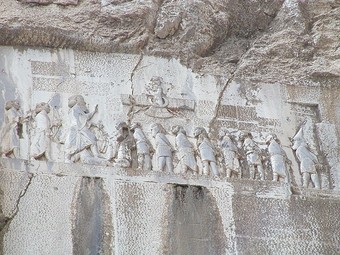
Behistun Inscription
A section of the Behistun Inscription on a limestone cliff of Mount Behistun in western Iran, which became a key in deciphering cuneiform script.
Commerce
and Trade
Under
the Achaemenids, trade was extensive and there was an efficient infrastructure
that facilitated the exchange of commodities in the far reaches of the empire.
Tariffs on trade were one of the empire’s main sources of revenue, in addition to agriculture and tribute.
The satrapies were linked by a 2,500-kilometer
highway, the most impressive stretch of which was the Royal Road, from Susa to
Sardis. The relays of mounted couriers could reach the most remote areas in 15
days. Despite the relative local independence afforded by the satrapy system, royal inspectors regularly
toured the empire and reported on local conditions using this route.
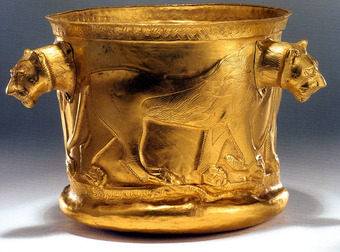
Achaemenid golden bowl with lion imagery
Trade in the Achaemenid Empire was extensive. Infrastructure, including the Royal Road, standardized language, and a postal service facilitated the exchange of commodities in the far reaches of the empire.
Military
Cyrus
the Great created an organized army to enforce national authority, despite the ethno-cultural
diversity among the subject nations, the empire’s enormous geographic size, and
the constant struggle for power by regional competitors.
This
professional army included the Immortals unit, comprising 10,000 highly trained
heavy infantry. Under Darius the Great, Persia would become the first empire to
inaugurate and deploy an imperial navy, with personnel that included Phoenicians,
Egyptians, Cypriots, and Greeks.
6.4.3: Zoroastrianism
Zoroastrianism, an ancient Persian religion, had a major influence on the culture and religion of all other monotheistic religions in the region.
Learning Objective
Explain Zoroastrianism and its impact on Persian culture
Key Points
- Zoroastrianism is ascribed to the teachings of Zoroaster, an Iranian prophet, who worshiped Ahura Mazda (Wise Lord), as its Supreme Being.
- Leading characteristics, such as messianism, heaven and hell, and free will are said to have influenced other religious systems, including Second Temple Judaism, Gnosticism, Christianity, and Islam.
- Zoroastrianism served as the state religion of the pre-Islamic Iranian empires from c. 600 BCE to 650 CE, but saw a steep decline after the Muslim conquest of Persia.
- The religion states that active participation in life through good deeds is necessary to ensure happiness and to keep chaos at bay.
Key Terms
- eschatological
-
A part of theology concerned with the final events of history, or the ultimate destiny of humanity, often referred to as the “end times.”
- Sassanids
-
The last Iranian empire before the rise of Islam.
- Gnosticism
-
A modern term categorizing a collection of ancient religions whose adherents shunned the material world—
which they viewed as created by the demiurge—and embraced the spiritual world.
- messianism
-
The belief in a messiah, who acts as a savior, redeemer or liberator of a group of people.
Overview and Theology
Zoroastrianism is one of the world’s oldest religions. It ascribed to the teachings of the Iranian prophet Zoroaster (or Zarathustra), and exalted their deity of wisdom, Ahura Mazda (Wise Lord), as its Supreme Being. Leading characteristics, such as messianism, heaven and hell, and free will are said to have influenced other religious systems, including Second Temple Judaism, Gnosticism, Christianity, and Islam. With possible roots dating back to the second millennium BCE, Zoroastrianism enters recorded history in the 5th-century BCE. It served as the state religion of the pre-Islamic Iranian empires from around 600 BCE to 650 CE. Zoroastrianism was suppressed from the 7th century onwards, following the Muslim conquest of Persia. Recent estimates place the current number of Zoroastrians at around 2.6 million, with most living in India and Iran.
The most important texts of the religion are those of the Avesta, which includes the writings of Zoroaster, known as the Gathas and the Yasna. The Gathas are enigmatic poems that define the religion’s precepts, while the Yasna is the scripture. The full name by which Zoroaster addressed the deity is: Ahura, The Lord Creator, and Mazda, Supremely Wise. He proclaimed that there is only one God, the singularly creative and sustaining force of the Universe. He also stated that human beings are given a right of choice, and because of cause and effect are also responsible for the consequences of their choices. The contesting force to Ahura Mazda was called Angra Mainyu, or angry spirit. Post-Zoroastrian scripture introduced the concept of Ahriman, the Devil, which was effectively a personification of Angra Mainyu.
In Zoroastrianism, water (apo, aban) and fire (atar, azar) are agents of ritual purity, and the associated purification ceremonies are considered the basis of ritual life. In Zoroastrian cosmogony, water and fire are respectively the second and last primordial elements to have been created, and scripture considers fire to have its origin in the waters. Both water and fire are considered life-sustaining, and both water and fire are represented within the precinct of a fire temple. Zoroastrians usually pray in the presence of some form of fire (which can be considered evident in any source of light), and the culminating rite of the principle act of worship constitutes a “strengthening of the waters.” Fire is considered a medium through which spiritual insight and wisdom is gained, and water is considered the source of that wisdom.
The religion states that active participation in life through good deeds is necessary to ensure happiness and to keep chaos at bay. This active participation is a central element in Zoroaster’s concept of free will, and Zoroastrianism rejects all forms of monasticism. Ahura Mazda will ultimately prevail over the evil Angra Mainyu or Ahriman, at which point the universe will undergo a cosmic renovation and time will end. In the final renovation, all of creation—even the souls of the dead that were initially banished to “darkness”—will be reunited in Ahura Mazda, returning to life in the undead form. At the end of time, a savior-figure (a Saoshyant) will bring about a final renovation of the world (frashokereti), in which the dead will be revived.
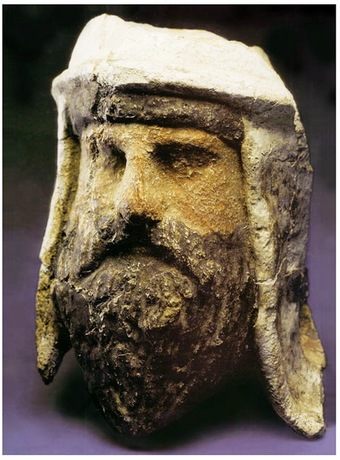
Zoroastrian Priest
Painted clay and alabaster head of a Zoroastrian priest wearing a distinctive Bactrian-style headdress, Takhti-Sangin, Tajikistan, Greco-Bactrian kingdom, 3rd-2nd century BCE.
History
The roots of Zoroastrianism are thought to have emerged from a common prehistoric Indo-Iranian religious system dating back to the early 2nd millennium BCE. The prophet Zoroaster himself, though traditionally dated to the 6th century BCE, is thought by many modern historians to have been a reformer of the polytheistic Iranian religion who lived in the 10th century BCE. Zoroastrianism as a religion was not firmly established until several centuries later. Zoroastrianism enters recorded history in the mid-5th century BCE. Herodotus’ The Histories (completed c. 440 BCE) includes a description of Greater Iranian society with what may be recognizably Zoroastrian features, including exposure of the dead.
The Histories is a primary source of information on the early period of the Achaemenid era (648-330 BCE), in particular with respect to the role of the Magi. According to Herodotus i.101, the Magi were the sixth tribe of the Medians (until the unification of the Persian empire under Cyrus the Great, all Iranians were referred to as “Mede” or “Mada” by the peoples of the Ancient World). The Magi appear to have been the priestly caste of the Mesopotamian-influenced branch of Zoroastrianism today known as Zurvanism, and they wielded considerable influence at the courts of the Median emperors.
Darius I, and later Achaemenid emperors, acknowledged their devotion to Ahura Mazda in inscriptions (as attested to several times in the Behistun inscription), and appear to have continued the model of coexistence with other religions. Whether Darius was a follower of Zoroaster has not been conclusively established, since devotion to Ahura Mazda was (at the time) not necessarily an indication of an adherence to Zoroaster’s teaching. A number of the Zoroastrian texts that today are part of the greater compendium of the Avesta have been attributed to that period.
The religion would be professed many centuries following the demise of the Achaemenids in mainland Persia and the core regions of the former Achaemenid Empire—
most notably Anatolia, Mesopotamia, and the Caucasus. In the Cappadocian kingdom (whose territory was formerly an Achaemenid possession), Persian colonists who were cut off from their co-religionists in Iran proper continued to practice the Zoroastrianism of their forefathers. There, Strabo, observing in the first century BCE, records that these “fire kindlers” possessed many “holy places of the Persian Gods,” as well as fire temples. Strabo furthermore relates, that they were “noteworthy enclosures; and in their midst there is an altar, on which there is a large quantity of ashes and where the magi keep the fire ever burning.” Throughout, and after, the Hellenistic periods in the aforementioned regions, the religion would be strongly revived.
As late as the Parthian period, a form of Zoroastrianism was without a doubt the dominant religion in the Armenian lands. The Sassanids aggressively promoted the Zurvanite form of Zoroastrianism, often building fire temples in captured territories to promote the religion. During the period of their centuries long suzerainty over the Caucasus, the Sassanids made attempts to promote Zoroastrianism there with considerable successes. It was also prominent in the pre-Christian Caucasus (especially modern-day Azerbaijan).
6.5: The Maurya Empire
6.5.1: Rise of the Maurya Empire
Chandragupta Maurya founded the Maurya Empire in 322 BCE when he conquered the kingdom of Magadha and the northwestern Macedonian satrapies.
Learning Objective
Understand the history and significance of the Maurya Empire
Key Points
- The Maurya Empire was founded in 322 BCE by Chandragupta Maurya, who had overthrown the Nanda Dynasty and rapidly expanded his power westward across central and western India in order to take advantage of the disruptions of local powers in the wake of the withdrawal by Alexander the Great’s armies.
- According to legend, the teacher Chanakya convinced his disciple, Chandragupta Maurya, to conquer the the kingdom of Magadha (the Nanda Empire) when he was insulted by its king Dhana Nanda.
- Chandragupta Maurya expanded the Maurya Empire north and west as he conquered the Macedonian Satrapies and won the Seleucid-Mauryan war.
- In its time, the Maurya Empire was one of the largest empires of the world.
Key Terms
- Takshashila
-
An early city in modern-day Pakistan that was believed to be one of the earliest global settings of learning and culture. It is now modern-day Taxila.
- Chanakya
-
Maurya’s teacher and loyal advisor during the foundation and expansion of the Maurya Empire.
- Nanda Empire
-
The kingdom led by Dhana Nanda; it was conquered by Chandragupta Maurya in 321 BCE.
- Chandragupta Maurya
-
The founder of the Maurya Empire; he lived from 340-298 BCE.
The Maurya Empire was a geographically extensive Iron Age historical power in ancient India, ruled by the Maurya dynasty from 322-185 BCE. Originating from the kingdom of Magadha in the Indo-Gangetic Plain (modern Bihar, eastern Uttar Pradesh) in the eastern side of the Indian subcontinent, the empire had its capital city at Pataliputra (modern Patna). The empire was the largest to have ever existed in the Indian subcontinent, spanning over 5 million square kilometres at its zenith under Ashoka.
The Empire was founded in 322 BCE by Chandragupta Maurya, who had overthrown the Nanda Dynasty, and rapidly expanded his power,with Chanakya’s help, westward across central and western India. His expansion took advantage of the disruptions of local powers in the wake of the withdrawal westward by Alexander the Great’s armies. By 316 BCE, the empire had fully occupied Northwestern India, defeating and conquering the satraps left by Alexander. Chandragupta then defeated the invasion led by Seleucus I, a Macedonian general from Alexander’s army, and gained additional territory west of the Indus River.
In its time, the Maurya Empire was one of the largest empires of the world. At its greatest extent, the empire stretched to the north along the natural boundaries of the Himalayas, to the east into Assam, to the west into Balochistan (southwest Pakistan and southeast Iran) and into the Hindu Kush mountains of what is now Afghanistan. The Empire was expanded into India’s central and southern regions by the emperors Chandragupta and Bindusara, but it excluded a small portion of unexplored tribal and forested regions near Kalinga (modern Odisha), until it was conquered by Ashoka. It declined for about 50 years after Ashoka’s rule ended, and it dissolved in 185 BCE with the foundation of the Shunga Dynasty in Magadha.
Conquest of Magadha and foundation of the Maurya Empire (c. 321 BCE)
According to several legends, Chanakya traveled to Magadha, a kingdom that was large and militarily powerful and feared by its neighbors, but was insulted by its king Dhana Nanda, of the Nanda Dynasty. Chanakya swore revenge and vowed to destroy the Nanda Empire.
The Nanda Empire originated from the region of Magadha in ancient India during the 4th century BCE, and lasted until between 345-321 BCE. At its greatest extent, the empire ruled by the Nanda Dynasty extended from Bengal in the east, to the Punjab region in the west, and as far south as the Vindhya Range. The rulers of this dynasty were famed for the great wealth that they accumulated.
Chanakya encouraged the young Chandragupta Maurya and his army to take over the throne of Magadha. Using his intelligence network, Chandragupta gathered many young men from across Magadha and other provinces, who were upset over the corrupt and oppressive rule of King Dhana, as well as the resources necessary for his army to fight a long series of battles. These men included the former general of Taxila, accomplished students of Chanakya, the representative of King Porus of Kakayee, his son Malayketu, and the rulers of small states.
Maurya devised a strategy to invade Pataliputra, the capital of the Nanda Empire. A battle was announced and the Magadhan army was drawn from the city to a distant battlefield in order to engage Maurya’s forces. Meanwhile, Maurya’s general and spies bribed the Nanda’s corrupt general, and created an atmosphere of civil war in the kingdom, which culminated in the death of the heir to the throne.
Upon the civil unrest in the kingdom, Nanda resigned and disappeared into exile. Chanakya contacted the prime minister, Rakshasa, and convinced him that his loyalty was to Magadha, not to the Nanda Dynasty, and that he should remain in office. Chanakya reiterated that choosing to resist would start a war that would severely affect Magadha and destroy the city. Rakshasa accepted Chanakya’s reasoning, and Chandragupta Maurya was legitimately installed as the new King of Magadha in 321 BCE, at the age of 21. Rakshasa became Chandragupta’s chief advisor, and Chanakya assumed the position of an elder statesman.
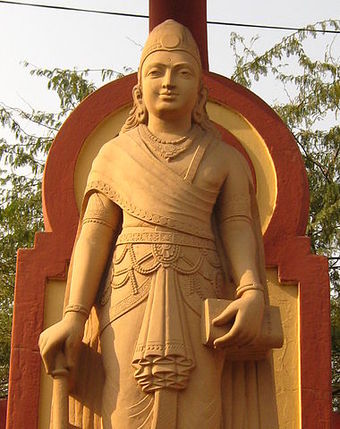
Statue of Chandragupta Maurya at the Birla Mandir Hindu temple, Delhi
Chandragupta Maurya conquered the kingdom of Magadha to found the Maurya Empire in 231 BCE, at the age of 21.
Northwest Expansion
With his new seat of power in Magadha, Chandragupta Maurya defeated the remaining Macedonian satraps, and consolidated his reign of the new Maurya Empire. He rapidly expanded his power westward across central and western India, taking advantage of the disruptions of local powers in the wake of the withdrawal westward by Alexander the Great’s Greek armies. By 320 BCE, the empire had fully occupied Northwestern India. Chandragupta Maurya would become the first emperor to unify India into one state, creating one of the world’s largest empires in its time, and the largest ever in the Indian subcontinent.
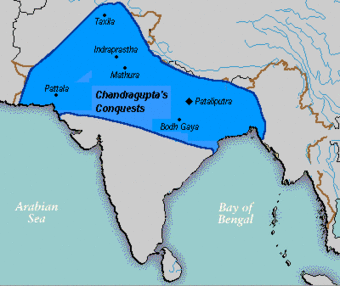
The Maurya Empire c. 320 BCE
The Maurya Empire when it was first founded by Chandragupta Maurya c. 320 BCE, after conquering the Nanda Empire when he was only about 20 years old.
6.5.2: Expansion of the Maurya Empire
After winning the Seleucid-Mauryan war, the Maurya Empire expanded into the southern Indian subcontinent under the rule of Ashoka the Great.
Learning Objective
Understand the expansion of the Maurya Empire
Key Points
- The Seleucid Empire tried and failed to reconquer the northwestern part of the Maurya Empire during the Seleucid-Mauryan war, from 305-303 BCE.
- As part of the peace offering, the Maurya Empire gained five territories in exchange for 500 war elephants.
- Several Greeks remained at the Mauryan court as ambassadors to the Hellenistic world.
- Chandragupta Maurya was succeed by his son, Bindusara, in 298 BCE, and then by Bindusara’s son, Ashoka the Great, in 272 BCE.
- Under Ashoka the Great, the Maurya Empire expanded into the southern part of the Indian subcontinent.
- Ashoka erected the Edicts of Ashoka, which state his policies and accomplishments, and which were written in both Greek and Sanskrit.
Key Terms
- satrapies
-
The governors of the provinces of the ancient Median and Achaemenid (Persian) Empires, and several of their successors, such as the Sasanian Empire and the Hellenistic empires.
- Edicts of Ashoka
-
Stone edicts that depicted the policies and accomplishments of Ashoka the Great, and were written in both Greek and Sanskrit.
- Ashoka the Great
-
Lived 304-232 BCE. As the king of the Maurya Empire, he conquered the Indian subcontinent.
- Seleucus
-
The king of the Seleucid Empire who tried to reconquer northwestern Indian, but lost the Selecucid-Mauryan War.
The Seleucid-Mauryan War
In 305 BCE, Emperor Chandragupta Maurya led a series of campaigns to retake the satrapies left behind by Alexander the Great when he returned westward. Seleucus I fought to defend these territories, but both sides made peace in 303 BCE.
Seleucus, one of Alexander’s generals, received Babylonia and, from there, expanded his dominions to include much of Alexander’s near eastern territories. Seleucus established himself in Babylon in 312 BC, the year used as the foundation date of the Seleucid Empire. He ruled not only Babylonia, but the entire enormous eastern part of Alexander’s empire. The Seleucid Empire was a major center of Hellenistic culture. In the areas where a Greek-Macedonian political elite dominated (mostly urban), it maintained the preeminence of Greek customs.
In 305 BCE, Seleucus I tried to reconquer the northwestern parts of India in order to claim them for the growing Seleucid Empire. Little is known of the campaign in which Chandragupta fought with Seleucus over the Indus Valley and the region of Gandhara—
a very wealthy kingdom that had submitted decades earlier to Alexander the Great.
Seleucus lost the Seleucid-Mauryan War, and the two rulers reconciled with a peace treaty. The Greeks offered a Macedonian princess for marriage to Chandragupta, and several territories, including the satrapies of Paropamisade (modern-day Kamboja and Gandhara), Arachosia (modern-day Kandhahar), and Gedrosia (modern-day Balochistan). In return, Chandragupta sent 500 war elephants, a military asset which would play a decisive role in Seleucus’ victory against western Hellenistic kings at the Battle of Ipsus in 301 BCE.
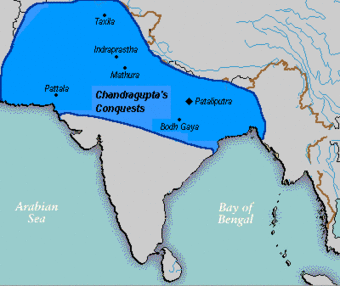
The Maurya Empire c. 305 BCE
Chandragupta extended the borders of the Maurya Empire toward Seleucid Persia, after defeating Seleucus c. 305 BCE.
In addition to this treaty, Seleucus dispatched two Greek ambassadors, Megasthenes and, later, Deimakos, to the Mauryan court at Pataliputra. Later, Ptolemy II Philadelphus, the ruler of Ptolemaic Egypt, sent an ambassador named Dionysius to the Mauryan court. Thus, continuing ties between the Hellenistic world and the Mauryan Empire.
Expansion Under Bindusara
Chandragupta Maurya ruled from 322 BCE until his voluntary retirement and abdication, in favor of his son, Bindusara, in 298 BCE. Bindusara (320-272 BCE) was the son of Maurya and his queen, Durdhara. During his reign, Bindusara expanded the Maurya Empire southward, with Chanakya as his advisor. He brought 16 states under the Maurya Empire and thus conquered almost all of the Indian peninsula. Bindusara ignored the friendly Dravidian kingdoms of the Cholas, ruled by King Ilamcetcenni, the Pandyas, and Cheras. Apart from these southern states, Kalinga (modern-day Odisha) was the only kingdom in India independent from Bindusara’s empire.
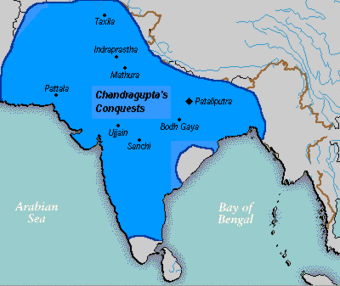
The Maurya Empire c. 290 BCE
Bindausara (ruler 298-272 BCE) extended the borders of the empire southward into the Deccan Plateau c. 290 BCE.
Ashoka the Great
Bindusara died in 272 BCE, and was succeeded by his son, Ashoka the Great (304-232 BCE). As a young prince, Ashoka (r. 272-232 BCE) was a brilliant commander who crushed revolts in Ujjain and Taxila. As monarch, he was ambitious and aggressive, reasserting the Empire’s superiority in southern and western India. But it was his conquest of Kalinga (262-261 BCE) that proved to be the pivotal event of his life. Although Ashoka’s army succeeded in overwhelming Kalinga forces of royal soldiers and civilian units, an estimated 100,000 soldiers and civilians were killed in the furious warfare, including over 10,000 of Ashoka’s own men. Hundreds of thousands of people were adversely affected by the destruction and fallout of war. When he personally witnessed the devastation, Ashoka began feeling remorse. Although the annexation of Kalinga was completed, Ashoka embraced the teachings of Buddhism, and renounced war and violence. He sent out missionaries to travel around Asia and spread Buddhism to other countries.
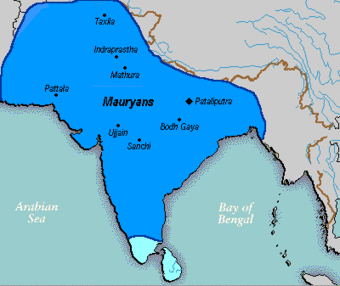
Extent of the Maurya Empire at its height in 265 BCE
Ashoka the Great extended into Kalinga during the Kalinga War c. 265 BCE, and established superiority over the southern kingdoms.
As ruler, Ashoka implemented principles of ahimsa (the principle of “to not injure”) by banning hunting and violent sports activities, and ending indentured and forced labor (many thousands of people in war-ravaged Kalinga had been forced into hard labor and servitude). While he maintained a large and powerful army to keep the peace, Ashoka expanded friendly relations with states across Asia and Europe, and sponsored Buddhist missions. He undertook a massive public works building campaign across the country. Among these works were the construction of stupas, or Buddhist religious structures, containing relics. One notable stupas created during the reign of Ashoka was The Great Stupa, which stands in Sanchi, India. Over 40 years of peace, harmony, and prosperity made Ashoka one of the most successful and famous monarchs in Indian history. He remains an idealized figure of inspiration in modern India.
The Edicts of Ashoka
Perhaps one of the greatest-known accomplishments of Ashoka was his creation of his edicts, which were erected between 269 BCE and 232 BCE. The Edicts of Ashoka, set in stone, are found throughout the Subcontinent. Ranging from as far west as Afghanistan, and as far south as Andhra (Nellore District), Ashoka’s edicts state his policies and accomplishments. Although predominantly written in Prakrit, two of them were written in Greek, and one in both Greek and Aramaic. Ashoka’s edicts refer to the Greeks, Kambojas, and Gandharas as peoples forming a frontier region of his empire. They also attest to Ashoka’s envoys’ travels to the Greek rulers in the west as far as the Mediterranean. Ashoka’s edicts also mentioned social and cultural attributes of his empire, emphasizing Buddhism, though not condemning other religions. For this, the Edicts of Ashoka are known as an early document that promoted religious tolerance.
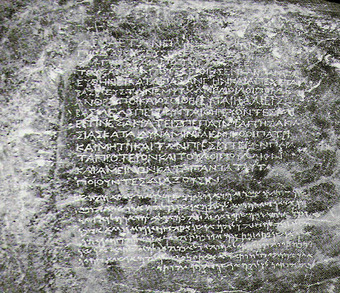
An Edict of Asoka
Bilingual inscription (Greek and Aramaic) by king Asoka, from Kandahar. Kabul Museum
6.5.3: Centralization in the Maurya Empire
The Mauryan Empire encouraged economic prosperity through political
stability and a unified central government.
Learning Objective
Describe the significance of the political stability offered by the Mauryan Empire
Key Points
-
The Mauryan Empire was divided
into four provinces, each governed by the Kumara,
who served as the king’s representative. - Emperor Ashoka maintained a
massive standing
army to
protect the Mauryan Empire and instill stability and peace across West and
South Asia. - Chandragupta
Maurya, Ashoka’s
grandfather, had established a single currency
across India, a network of regional governors and administrators, and a civil
service to provide justice and security for merchants, farmers and traders that
continued throughout the Mauryan Dynasty. - The Mauryan international network
of trade extended to the Greek states and Hellenic kingdoms
in West Asia and into Southeast Asia.
Key Terms
- Arthashastra
-
An ancient Indian treatise on government, statecraft, military, and economy.
- Khyber Pass
-
A strategically important trade stop on the modern boundary of Pakistan and Afghanistan.
- standing army
-
A permanent army composed of full-time soldiers that is not disbanded during times of peace.
- Kumara
-
A royal prince who oversaw the Mauryan provinces on behalf of the emperor.
Employing
a carefully organized bureaucratic system, the Maurya Empire was able to
maintain security and political unity across large parts of western and southern
Asia. This included a common economic system supporting stable agriculture in
its vast landholdings, as well as successful trade and commerce. Through this
centralized authority, which included a powerful military, the rulers of the
empire bound together the previously fractured regions of the Indian Subcontinent.
Unification
and Military
Chandragupta
Maurya, the founder of the Maurya Empire, ruled from 324-297 BCE, before voluntarily abdicating in favor of his son, Bindusara, who ruled
from 297 BCE until his death in 272 BCE. This led to a war of succession in which Bindusara’s
son, Ashoka, defeated his brother, Susima, and rose to the throne in 268 BCE, eventually
becoming the greatest ruler of the Maurya Dynasty.
Before
the Mauryan Empire, the Indian subcontinent was fragmented into hundreds of
kingdoms. These were ruled by powerful regional chieftains with small armies that
engaged in internecine warfare. The Mauryan Army eliminated regional chieftains,
private armies, and even gangs of bandits, who sought to impose their own
supremacy in small areas.
The Mauryan
Army, the largest standing military force of its time, supported the expansion
and defense of the empire. According to scholars, the empire wielded 600,000
infantry, 30,000 cavalry, and 9,000 war elephants, while a vast espionage system
collected intelligence for both internal and external security purposes. Although
Emperor Ashoka renounced offensive warfare and expansionism, he maintained this
standing army to protect the empire from external threats and maintain
stability and peace across Western and Southern Asia.
Administration
The Mauryan
Empire was divided into four provinces, with the imperial capital at
Pataliputra, near the Ganges River in the modern state of Bihar in India. The Edicts of Ashoka, a collection of inscriptions
made during Ashoka’s reign from 268-232 BCE, give the names of the Maurya
Empire’s four provincial capitals: Tosali in the east, Ujjain in the west,
Suvarnagiri in the south, and Taxila in the north.
The
organizational structure began at the imperial level with the emperor and his
Mantriparishad, or Council of Ministers. The head of the provincial
administration was the Kumara, or royal prince, who governed the provinces as the
king’s representative, with the assistance of Mahamatyas, who were essentially regional
prime ministers. Through this sophisticated system of bureaucracy, the empire governed
all aspects of government at every level, from municipal hygiene to
international trade.
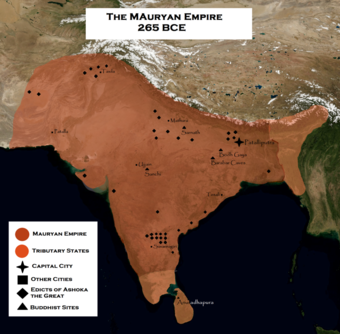
Maurya Empire at its greatest extent (dark orange), including vassal kingdoms (light orange), 265 BCE
The Maurya Empire provided political stability with a unified central government, which in turn encouraged economic prosperity.
Centralization
and Taxation
Chandragupta
Maurya, the father of the dynasty, established a single currency across India,
a network of regional governors and administrators, and a civil service to
provide justice and security for merchants, farmers, and traders.
Through
the disciplined central authority of the Mauryan Empire, farmers were freed of
tax and crop collection burdens from regional kings. Instead, they paid a
nationally administered system of taxation that was strict but fair. The system
operated under the principles of the Arthashastra,
an ancient Indian treatise on economic policy, statecraft, and military
strategy. Written in Sanskrit and adhering to Hindu philosophies, the Arthashastra includes books on the
nature of government, law, civil and criminal courts, ethics, and economic
topics, including markets and trade, agriculture, mineralogy, mining and metals,
forestry, and others.
Although
regimental in revenue collection, the Mauryan Empire funded numerous public
works projects to enhance productivity. Like his father and grandfather, Ashoka
sponsored the construction of thousands of roads, waterways, canals, rest houses,
hospitals, and other types of infrastructure.
Under
continued Mauryan rule, political unity and military security encouraged a
common economic system, increased agricultural productivity, and enhanced widespread
trade and commerce for the first time in West and South Asia.
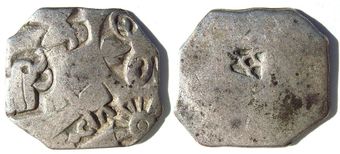
Coins of the Maurya Empire
Chandragupta Maurya established a single currency across India, including these silver punch mark coins with symbols of wheel and elephant, 3rd century BCE
Trade and
Commerce
The Maurya
Empire’s political unity and internal peace encouraged the expansion of trade
in India. Under the Indo-Greek friendship treaty during Ashoka’s reign, the
Mauryan international network of trade saw great expansion.
The Khyber Pass, on the modern boundary of
Pakistan and Afghanistan, became a strategically important point of trade and interaction
with the outside world. Greek states and Hellenic kingdoms in West Asia became
trading partners. Trade also extended through the Malay Peninsula into
Southeast Asia. India’s exports included silk, textiles, spices, and exotic
foods. The outside world gained new scientific knowledge and
technology through expanded trade with the Mauryan Empire.
6.5.4: Ashoka’s Conversion
Mauryan emperor Ashoka embraced Buddhism after witnessing the mass deaths of the Kalinga War, which he himself had waged out of a desire for conquest.
Learning Objective
Discuss the effects of Ashoka the Great’s conversion to Buddhism
Key Points
- While the early part of Ashoka’s reign was apparently quite bloodthirsty, he became a follower of the Buddha’s teachings after his conquest of Kalinga.
- According to a contemporary text, the Edicts of Ashoka, Ashoka converted to Buddhism because he “felt remorse on account of the conquest of Kalinga because, during the subjugation of a previously unconquered country, slaughter, death, and taking away captive of the people necessarily occur.”
- In one source, his conversion is presented as a gradual process coming from intense personal anguish, rather than spurred by a specific event.
- As a Buddhist emperor, Ashoka believed that Buddhism is beneficial for all human beings, as well as animals and plants, so he built a number of stupas. He also well spread Buddhism to neighboring kingdoms.
Key Terms
- Edicts of Ashoka
-
A collection of 33 inscriptions on the Pillars of Ashoka, as well as boulders and cave walls, made by the Emperor Ashoka of the Mauryan Empire during his reign, from 269 BCE to 232 BCE.
- Dharma
-
Cosmic law and order, behaviors that are considered to be in accord with the order that makes life and the universe possible, including duties, rights, laws, conduct, virtues, and ‘‘right way of living.” Also specifically signifies the teachings of the Buddha.
Background: Conquest of Kalinga
While the early part of Ashoka’s reign was apparently quite bloodthirsty, he became a follower of the Buddha’s teachings after his conquest of Kalinga on the east coast of India in the present-day states of Odisha and North Coastal Andhra Pradesh. Kalinga was a state that prided itself on its sovereignty and democracy. With its monarchical parliamentary democracy, it was quite an exception in ancient Bharata where there existed the concept of Rajdharma. Rajdharma means the duty of the rulers, which was intrinsically entwined with the concept of bravery and dharma. The Kalinga War happened eight years after his coronation. From Ashoka’s 13th inscription, we come to know that the battle was a massive one and caused the deaths of more than 100,000 soldiers and many civilians who rose up in defence; over 150,000 were deported. When he was walking through the grounds of Kalinga after his conquest, rejoicing in his victory, he was moved by the number of bodies strewn there and the wails of the bereaved.
Conversion to Buddhism
Edict 13 on the Edicts of Ashoka Rock Inscriptions reflect the great remorse the king felt after observing the destruction of Kalinga:
His Majesty felt remorse on account of the conquest of Kalinga because, during the subjugation of a previously unconquered country, slaughter, death, and taking away captive of the people necessarily occur, whereas His Majesty feels profound sorrow and regret.
The edict goes on to address the even greater degree of sorrow and regret resulting from Ashoka’s understanding that the friends and families of deceased would suffer greatly too.
Legend says that one day after the war was over, Ashoka ventured out to roam the city and all he could see were burnt houses and scattered corpses. The lethal war with Kalinga transformed the vengeful Emperor Ashoka into a stable and peaceful emperor, and he became a patron of Buddhism. According to the prominent Indologist, A. L. Basham, Ashoka’s personal religion became Buddhism, if not before, then certainly after the Kalinga War. However, according to Basham, the Dharma officially propagated by Ashoka was not Buddhism at all. Nevertheless, his patronage led to the expansion of Buddhism in the Mauryan empire and other kingdoms during his rule, and worldwide from about 250 BCE.
After the Kalinga War and Ashoka’s conversion, the Empire experienced nearly half a century of peace and security. Mauryan India also enjoyed an era of social harmony, religious transformation, and expansion of the sciences and of knowledge. Chandragupta Maurya’s embrace of Jainism increased social and religious renewal and reform across his society, while Ashoka’s embrace of Buddhism has been said to have been the foundation of the reign of social and political peace and non-violence across all of India.
Buddhist Kingship
One of the more enduring legacies of Ashoka Maurya was the model that he provided for the relationship between Buddhism and the state. Throughout Theravada Southeastern Asia, the model of rulership embodied by Ashoka replaced the notion of divine kingship that had previously dominated (in the Angkor kingdom, for instance). Under this model of “Buddhist kingship,” the king sought to legitimize his rule, not through descent from a divine source, but by supporting and earning the approval of the Buddhist sangha. Following Ashoka’s example, kings established monasteries, funded the construction of stupas, and supported the ordination of monks in their kingdom. Many rulers also took an active role in resolving disputes over the status and regulation of the sangha, as Ashoka had by calling a conclave to settle a number of contentious issues during his reign. This development ultimately led to a close association in many Southeast Asian countries between the monarchy and the religious hierarchy, an association that can still be seen today in the state-supported Buddhism of Thailand, and the traditional role of the Thai king as both a religious and secular leader. Ashoka also said that his courtiers always governed the people in a moral manner.
As a Buddhist emperor, Ashoka believed that Buddhism is beneficial for all human beings, as well as animals and plants, so he built a number of stupas, Sangharama, viharas, chaitya, and residences for Buddhist monks all over South Asia and Central Asia. According to the Ashokavadana, he ordered the construction of 84,000 stupas to house the Buddhas relics. In the Aryamanjusrimulakalpa, Ashoka takes offerings to each of these stupas, traveling in a chariot adorned with precious metals. He gave donations to viharas and mathas. He sent his only daughter, Sanghamitra, and son, Mahindra, to spread Buddhism in Sri Lanka (then known as Tamraparni).
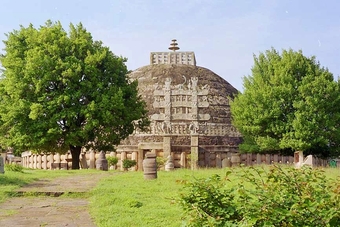
Stupa
Great Stupa (3rd century BC), Sanchi, India. Ashoka ordered the construction of 84,000 stupas to house the Buddhas relics.
Debate About Ashoka’s Conversion and Rule
The use of Buddhist sources in reconstructing the life of Ashoka has had a strong influence on perceptions of Ashoka, as well as the interpretations of his Edicts. Building on traditional accounts, early scholars regarded Ashoka as a primarily Buddhist monarch who underwent a conversion to Buddhism and was actively engaged in sponsoring and supporting the Buddhist monastic institution. Some scholars have tended to question this assessment. The only source of information not attributable to Buddhist sources are the Ashokan Edicts, and these do not explicitly state that Ashoka was a Buddhist. In his edicts, Ashoka expresses support for all the major religions of his time: Buddhism, Brahmanism, Jainism, and Ajivikaism. His edicts addressed to the population at large (there are some addressed specifically to Buddhists, which is not the case for the other religions) generally focus on moral themes that members of all the religions would accept.
However, the edicts alone strongly indicate that he was a Buddhist. In one edict he belittles rituals, and he banned Vedic animal sacrifices; these strongly suggest that he at least did not look to the Vedic tradition for guidance. Furthermore, many edicts are expressed to Buddhists alone; in one, Ashoka declares himself to be an “upasaka,” and in another he demonstrates a close familiarity with Buddhist texts. He erected rock pillars at Buddhist holy sites, but did not do so for the sites of other religions. He also used the word “dhamma” to refer to qualities of the heart that underlie moral action; this was an exclusively Buddhist use of the word. Finally, he promoted ideals that correspond to the first three steps of the Buddha’s graduated discourse.
Interestingly, the Ashokavadana, presents an alternate view of the familiar Ashoka. In this source, his conversion has nothing to do with the Kalinga War or his descent from the Maurya dynasty. Instead, Ashoka’s reason for adopting non-violence appears much more personal. The Ashokavadana shows that the main source of Ashoka’s conversion, and the acts of welfare that followed, are rooted instead in intense personal anguish, from a wellspring inside himself rather than spurred by a specific event. It thereby illuminates Ashoka as more humanly ambitious and passionate, with both greatness and flaws. This Ashoka is very different from the “shadowy do-gooder” of later Pali chronicles.
6.5.5: Decline of the Maurya Empire
The Sunga Dynasty usurped the Maurya Dynasty, and parts of the
empire were incorporated into the Indo-Greek Kingdom.
Learning Objective
Describe the factors that contributed to the decline of the Maurya Empire
Key Points
-
Ashoka
the Great’s rule was followed by 50 years of weak kings who did
not retain strong central authority. This eventually led to the dissolution of
the Maurya Empire. - General Pusyamitra Sunga staged
a coup against
the Maurya Dynasty in 185 BCE. As a result, he ascended the throne and founded the Sunga Dynasty. - In 180 BCE, the Greco-Bactrian
King Demetrius conquered the northwestern Indian territories and founded the
Indo-Greek Kingdom. - Buddhism lost
favor when the Sunga Dynasty gained power, but remained dominant in the
Ind0-Greek Kingdom.
Key Terms
- Khyber Pass
-
A mountain pass
connecting Afghanistan and Pakistan; it has been an important trade route
between Central Asia and South Asia, and a strategic military location. - Demetrius
-
The
Greco-Bactrian king who established the Indo-Greek kingdom when he conquered
parts of northwestern India, around 180 BCE. - Sunga
-
The dynasty founded by the general Pusyamitra Sunga after he staged a coup against the Maurya dynasty in 185 BCE.
- Buddhism
-
A religion encompassing a variety of traditions, beliefs, and spiritual practices largely based on teachings attributed to the Buddha.
A
50-year succession of weak kings followed the reign of Ashoka the Great, the
Indian emperor of the Maurya Dynasty who died in 232 BCE.
As Ashoka’s highly centralized government lost power, the Maurya Empire lost
control over its territories. The different cultures and economies began to
break apart, although the kings maintained Buddhism as the state religion.
Sunga Coup
and Rule
Brihadratha,
the last ruler of the Maurya Dynasty, was assassinated in 185 BCE. The
commander-in-chief of his guard, Brahmin General Pusyamitra Sunga, killed Brihadratha
during a military parade and ascended the throne. He established the Sunga Dynasty,
which prospered from approximately 187 to 78 BCE. Pusyamitra was succeeded
after 36 years by his son, Agnimitra, beginning the dynasty of ten Sunga rulers
overall. They conducted wars with both foreign and indigenous powers, including
the Kalinga, the Satavahana Dynasty, and the Indo-Greek Kingdom. The Sungas were
succeeded by the Kanva Dynasty around 73 BCE.
Sunga rulers helped establish the tradition of royal sponsorship of education
and the arts at a time when some of the most important developments in Hindu
thought were taking place. The Mathura art style took hold during this time,
and many small terracotta images, larger stone sculptures, and architectural
monuments from the Sunga period are still in existence.
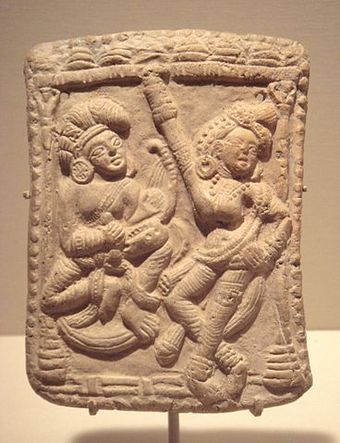
Sunga Royal Family, c. 150 BCE
Art and learning prospered under Sunga patronage, as seen in this terracotta tablet of the Sunga Royal family.
Sunga and
Buddhism
The
Sungas favored Hinduism over Buddhism. Buddhist sources, such as the Ashokavadana, an Indian
Sanskrit text describing the birth and reign of Ashoka the Great, mention that
Pusyamitra was hostile towards Buddhists and allegedly persecuted members of
the Buddhist faith. A large number of Buddhist monasteries, called viharas,
were allegedly converted to Hindu temples in such places as Nalanda, Bodhgaya,
Sarnath, or Mathura. Some historians argue, however, that Buddhist accounts of Sunga
persecution are largely exaggerated.
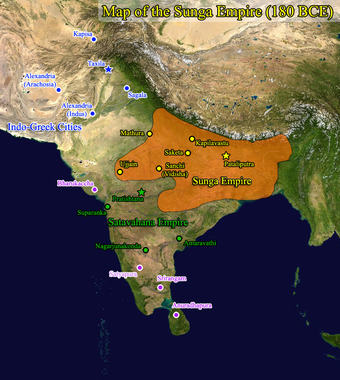
Sunga Empire, c. 185 BCE
The Sunga Dynasty was established following a coup by General Pusyamitra Sunga, marking the end of the Maurya Empire.
Indo-Greek
Kingdom
In
the east, the fall of the Mauryas left the Khyber Pass unguarded, and a wave of foreign
invasion followed. The Greco-Bactrian king, Demetrius, capitalized on the break-up and
conquered southern Afghanistan and parts of northwestern India around 180 BCE,
forming the Indo-Greek Kingdom. The Indo-Greeks maintained territorial holdings
for about a century in the Trans-Indus Region, in what is now Pakistan and parts of central India.
Demetrius, who lived from 175 to 140 BCE, founded the city of Sirkap,
combining Greek and Indian influences without signs of segregation between the
two cultures. The Greek expansion into Indian territory may have been intended
to protect Greek populations in India, as well as to protect the Buddhist faith
from the alleged religious persecutions of the Sungas.
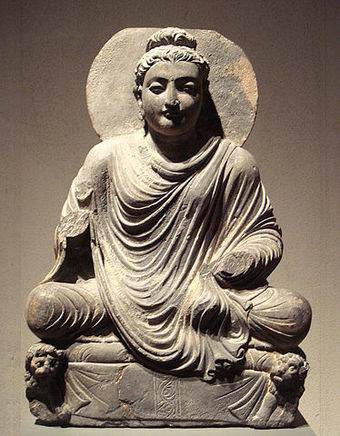
Seated Buddha statue showing Greek influences
Buddhism was favored in the Indo-Greek Kingdom. Many statues of Buddha from this period display Greek stylistic elements including Greek clothing.
Demetrius
was succeeded by Menander, who conquered the largest territory and was one of
the most successful Indo-Greek kings. His coins that have been discovered are
the most numerous and widespread of all the Indo-Greek kings. According to
Buddhist literature, Menander converted to Buddhism and is sometimes described
as the Milinda Panha. He helped Buddhism flourish and established the new
capital of Sagala.
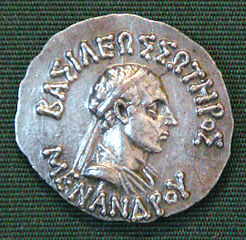
Coin depicting Menander I
Described in both Greek and Indian accounts, Menander I became the most important of the Indo-Greek rulers. He converted to Buddhism and expanded the Indo-Greek Kingdom.
In
Indian literature, the Indo-Greeks are described as “Yavanas” in
Sanskrit, or “Yonas” in Pali, which are both thought to be
transliterations of “Ionians.” The Buddhist scripture, Majjhima Nikaya, explains that in
contrast with the numerous Indian castes, there were only two classes of
people in Indo-Greek culture: the Aryas, translated as the masters; and Dasas,
the servants.
Indo-Greek
Fall
Throughout the first century BCE, the Indo-Greeks progressively lost
ground to the Indians in the East, and the Scythians, the Yuezhi, and the Parthians in the
West. About 20 Indo-Greek kings are known during this period, including last
known Indo-Greek ruler, Strato II, who ruled in the Punjab region until around
55 BCE.
6.6: The Kushan Empire
6.6.1: Expansion and Decline of the Kushan Empire
The Kushan Empire expanded from Greco-Bactrian lands
into China and India, until its collapse in 375 CE.
Learning Objective
Explain the importance of the Kushan Empire
Key Points
-
The Yuezhi invaded
the Greco-Bactrian
kingdom around
135 BCE, displacing the Greek dynasties. The
Kushans, a Yuezhi branch,
spread south into the region traditionally known as
Gandhara, and then expanded across the northern parts of the Indian
subcontinent. - Around 152 CE, the emperor Kanishka sent his armies north to capture
territories in present-day western China, and south into modern central India. A
direct road from the Kushan Empire and China, as well as the security offered by the
Kushan Empire, facilitated trade with the Roman Empire, Sassanid Persia,
Aksumite Empire, and Han China. -
The Kushans were influenced by
the Hellenistic kingdoms, and maintained a wide variety of faiths, including Zoroastrianism, Buddhism, and Hinduism. - Kushan control fragmented into
semi-independent kingdoms as the Sassanians attacked from the west and the
Guptas attacked from the east, collapsing the Kushan Empire around 375 CE.
Key Terms
- Greco-Bactrian Kingdom
-
The easternmost
part of the Hellenistic world, covering Bactria and Sogdiana in Central Asia
from 250-125 BCE. The Greco-Bactrians expanded into northern India and established
the Indo-Greek Kingdom in 180 BCE, which lasted until around 10 CE. - The Kushans
-
One of five branches of the Yuezhi, who invaded Bactria in 135 BCE, and spread southeast to form the Kushan Empire around 30 CE.
- Yuezhi
-
An ancient Indo-European people who originally settled in the grasslands of the eastern Tarim Basin, part of modern China.
- Zoroastrianism
-
One of the world’s oldest monotheistic religions, founded by the Prophet Zoroaster in ancient Iran approximately 3,500 years ago.
- Indo-Sassanids
-
A branch of the
Sassanid Persians, who established their rule in the northwestern Indian
subcontinent during the third and fourth centuries, at the expense of the
declining Kushans. - Kanishka
-
Buddhist emperor who expanded the Kushan Empire east into the middle of the Indian subcontinent, and north into China.
The
Kushan Empire in South Asia originally formed in the early 1st century CE, in the territories of ancient Bactria, around the Oxus River in Central
Asia. The Kushans spread from the Kabul River Valley to defeat other Central
Asian tribes. These conquests included parts of the northern central Iranian
Plateau, once ruled by the Parthian Empire—
a major political and cultural power
in ancient Iran and Iraq. The Kushans reached their peak under Emperor Kanishka
(127-151 CE), a Buddhist whose realm stretched from China to northern and
eastern India and parts of Pakistan.
Kushan Origins
(30-375 CE)
The
Kushans were one of five branches of the Yuezhi confederation, an Indo-European
nomadic people. The Yuezhi lived in the grasslands
of eastern Central Asia’s Tarim Basin, in modern-day Xinjiang, China (possibly
speaking varieties of Indo-European languages), until they were driven west by
the Xiongnu in 176-160 BCE.
The
Yuezhi reached the Greco-Bactrian Kingdom, located in northern Afghanistan and
Uzbekistan, around 135 BCE, and displaced the Greek dynasties that resettled to
the southeast in areas of the Hindu Kush and the Indus basin, in present-day
Afghanistan and Pakistan. The Kushans spread out from Bactria to defeat other
Central Asian tribes.
Kushan Expansion
As they wrested territories from the Scythian tribes, the Kushans
expanded south into the region traditionally known as Gandhara, establishing
the twin capitals Kapisa and Pushklavati, near modern-day Kabul and Peshawar,
respectively. During the 1st and early 2nd centuries CE, the Kushans expanded
across the northern parts of the Indian subcontinent. Around 152 CE, Emperor
Kanishka, a Buddhist, sent his armies north of the Karakoram Mountains to
capture additional territories, and subsequently opened a direct road from
Gandhara to China that remained under Kushan control for more than a century.
Diplomacy
and Trade
At
the height of the dynasty, the Kushans loosely ruled a territory that extended
to the Aral Sea through present-day Uzbekistan, Afghanistan, and Pakistan, into
northern India. They had diplomatic contacts with the Roman Empire, Sassanid
Persia, Aksumite Empire, and Han China. The Kushan Empire linked the seagoing
trade of the Indian Ocean with the commerce of the Silk Road, via the Indus Valley, while
providing security that encouraged travel across the Khunjerab Pass and
facilitated the spread of Mahayana Buddhism to China.
Culture
and Religion
Although
philosophy, art, and science developed within its borders, the only textual
record we have of the Kushan Empire’s history comes from inscriptions and
accounts in other languages, particularly Chinese. The Kushans are believed to
have been predominantly practitioners of Zoroastrianism, one of the world’s
oldest monotheistic religions founded by the Prophet Zoroaster in ancient Iran
approximately 3,500 years ago. Yet, the Kushans also adopted aspects of Buddhist
culture and, like the Egyptians, absorbed remnants of the Greek culture of the
Hellenistic kingdoms. Kushan emperors represented a wide variety of faiths, including Zoroastrianism, Buddhism, and possibly Saivism, a sect of Hinduism.
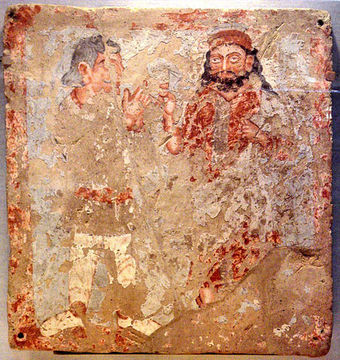
Kushan worshipper with Zeus/Serapis/Ohrmazd, 3rd century CE
The Kushans were influenced by the Hellenistic kingdoms and maintained a wide variety of faiths, including Zoroastrianism, Buddhism, and Hinduism.
Kushan Decline
After
the death of Emperor Vasudeva I in 225, the Kushan Empire split into western
and eastern halves. The western Kushans in Afghanistan were soon conquered by
the Persian Sassanid Empire. In 248 CE, they were defeated again by Persians,
who deposed the western dynasty and replaced them with Persian vassals—
cities or
kingdoms that forfeited foreign policy independence, in exchange for full
autonomy and, in some cases, formal tribute—known as the Indo-Sassanids, or Kushanshas.
The eastern
Kushan kingdom was based in the Punjab. Around 270 CE, their territories on the
Gangetic Plain became independent under local dynasties, such as the Yaudheyas.
In the mid-4th century they were subjugated by the Gupta Empire under its
leader, Samudragupta. The last of the Kushan and Sassanian kingdoms were eventually
overwhelmed by the Hepthalites, another Indo-European people from the north.
6.7: The Gupta Empire
6.7.1: Rise of the Gupta Empire
From 320-550 CE, the Gupta Empire assimilated neighboring kingdoms, through
conquest or political alliances.
Learning Objective
Explain the factors that contributed to the rise of the Gupta Empire
Key Points
- Sri Gupta founded the Gupta
Empire c. 240-280 CE, and was succeeded by his son, Ghatotkacha, c. 280-319 CE, followed
by Ghatotkacha’s son, Chandragupta, c. 319-335 CE. - After Chandragupta married
princess Kumaradevi from the kingdom of Magadha, he conquered or assimilated
the nearby kingdoms and assumed the imperial title of Maharajadhiraja, meaning “King of Kings.” - Chandragupta’s son, Samudragupta,
assumed the throne in 335 CE, and conquered several neighboring kingdoms; eventually, the Gupta Empire extended across the entire Indian subcontinent. - Samudragupta was succeeded by his
son, Chandragupta
II, who continued to expand the Gupta Empire through
conquest and political alliances.
Key Terms
- Maharajadhiraja
-
A Sanskrit title
for “Prince of Princes” or “King of Kings,” several
degrees higher than the title Maharaja, which means “Great King.” - Ashwamedha
-
A Vedic ritual
horse sacrifice; Samudragupta commemorated his territorial conquests with one
of these rituals.
The
Gupta Empire, founded by Maharaja Sri Gupta, was an ancient Indian realm that covered much of the Indian Subcontinent from approximately 320-550 CE. Gupta rule, while solidified by territorial expansion through
war, began a period of peace and prosperity marked by advancements in science,
technology, engineering, art, dialectics, literature, logic, mathematics,
astronomy, religion, and philosophy.
Gupta
Empire Origins
The
Gupta Empire was believed to be a dynasty of the Vaishya caste, the third of
the four Hindu castes representing merchants and farmers. Founded by Sri Gupta
c. 240-280 CE, there are contradictory theories regarding the original homeland
of the Guptas. Historians believe Sri Gupta and his son may have been Kushan vassals, or
rulers who swore allegiance to the Kushan Empire. Sri Gupta’s son and successor, Ghatotkacha, ruled
from c. 280-319 CE, while his son, Chandragupta, ascended the throne around 319
and ruled until 335 CE.
Chandragupta married princess Kumaradevi from the Kingdom of Magadha,
which was one of the Mahajanapadas (or great countries) of ancient India during
the 4th century CE. With a dowry and political alliance from the marriage,
Chandragupta conquered or assimilated the kingdoms of Magadha, Prayaga, and
Saketa. By 321 CE, he established a realm stretching along the Ganges River to
Prayag, the modern-day city of Allahabad, in the Indian state of Uttar Pradesh.
Hindus believe the god Brahma offered his first sacrifice after creating the
world at Prayag.
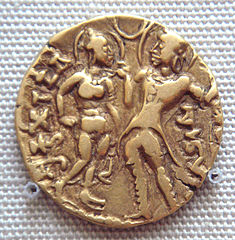
Queen Kumaradevi and King Chandragupta I
A coin from the period of
Indian Emperor Samudragupta, 335-380 CE, depicting his parents, King Chandragupta
and Queen Kumaradevi.
Gupta
Empire Expansion
Samudragupta
succeeded his father, Chandragupta I, in 335 CE, and ruled for about 45 years.
He conquered the kingdoms of Ahichchhatra and Padmavati early in his reign,
then attacked neighboring tribes, including the Malwas, Yaudheyas, Arjunayanas, Maduras,
and Abhiras. By his death in 380 CE, Samudragupta had incorporated over 20
kingdoms into his realm, and extended the Gupta Empire from the Himalayas to the
Narmada River in central India, and from the Brahmaputra River that cuts through
four modern Asian nations to the Yamuna—
the longest tributary of the Ganges
River in northern India.
To
celebrate his conquest, Samudragupta performed the royal Vedic ritual of Ashwamedha, or horse sacrifice. Special
coins were minted to commemorate the Ashvamedha, and the king took the title of
Maharajadhiraja (or “King of Kings”) even higher than the traditional
ruler’s title of Maharaja.
According
to the Gupta records, Samudragupta nominated his son, Prince Chandragupta II,
born of Queen Dattadevi, as his successor. However, his eldest son, Ramagupta,
may have been his immediate successor until he was dethroned by Chandragupta II
in 380 CE.
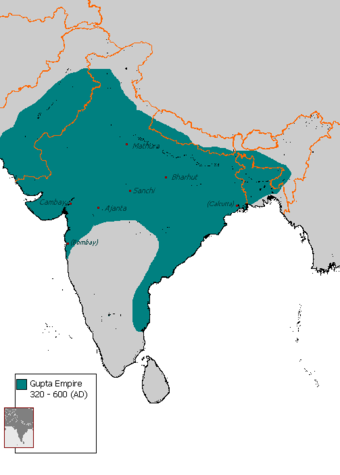
Gupta Empire, 320-600 CE
The Gupta Empire expanded through conquest and political alliances until 395 CE, when it extended across the entire Indian subcontinent.
Gupta
Empire of Chandragupta II
After
gaining power, Chandragupta II expanded the Gupta Empire through conquest and
political marriages until the end of his reign in 413 CE. By 395 CE, his
control over India extended coast-to-coast. At the high point of his rule, Chandragupta
II established a second capital at Ujjain, the largest city in the modern state
of Madhya Pradesh in central India. Ujjain, on the eastern bank of the Kshipra
River, remained an important political, commercial, and cultural hub through the
early 19th century.
Vikramaditya
is the name of an emperor of ancient Indian legend, characterized as the ideal
king known for generosity, courage, and as a patron of scholars. A number of
historians believe that some of these legends are based on Chandragupta II, who
is thought to have adopted the title of Vikramaditya.
In
the legends, Vikramaditya is said to have thwarted an invasion by the Saka, a
group of eastern Iranian nomadic tribes, also known as Scythians, and gained the
title of Sakari, or Enemy of the Saka. Chandragupta II conquered the western
Indian region of Malwa after defeating the Western Kshatrapas, a branch of the
Sakas, as well as expelling the Kushana Empire from the northern Indian
city state Mathura. These victories were likely transposed onto the legendary character
of Vikramaditya.
Chandragupta
II issued gold coin types introduced by his father, Samudragupta, but also
introduced several new types of coins, differentiated by the designs on the
face of each coin line, such as the Archer or the Tiger-Slayer. He was also the
first Gupta king to issue silver coins.
One
of the most curious structures in Delhi, India (an iron pillar dating back to
the 4th century CE) bears an inscription stating that it was erected as a
flagstaff in honor of the Hindu god Vishnu, and in memory of Chandragupta II.
The pillar, made of 98% wrought iron, is considered a highlight of ancient
Indian achievements in metallurgy; it has stood more than 1,600 years
without rusting or decomposing.
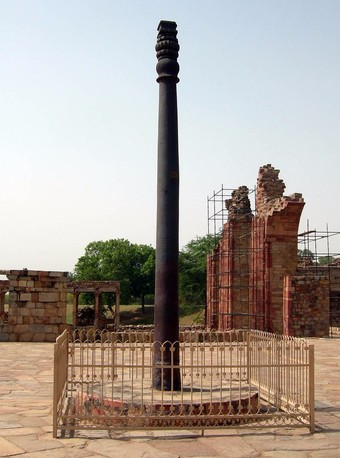
Iron Pillar of Delhi
The Iron Pillar of Delhi, India, erected by Chandragupta II to honor the Hindu god Vishnu, in the 4th century CE.
Despite
the expansion of the Gupta Empire through war, there were numerous examples of
cultural sophistication during the Gupta era, with architecture, sculptures and
paintings surviving as reminders of the creativity of the time. Under Gupta
rule, a number of notable scholars thrived, including Kalidasa, considered the
greatest poet and dramatist of the Sanskrit language; Aryabhata, the first of
the Indian mathematician-astronomers who worked on the approximation for Pi; Vishnu Sharma, thought to be the author
of the Panchatantra fables, one of
the most widely-translated, non-religious books in history; and the Hindu
philosopher Vatsyayana, author of the Kama
Sutra.
The
period of Gupta rule, especially the reign of Chandragupta II, is still remembered
as the Golden Age of India.
6.7.2: The Golden Age of India
The prosperity of the Gupta Empire produced a golden age of
cultural and scientific advancements.
Learning Objective
Understand the significance of the Golden Age of India
Key Points
-
Prosperity in the Gupta
Empire initiated a period known as the Golden Age of India, marked by extensive
inventions and discoveries in science, technology, engineering, art, dialectic,
literature, logic, mathematics, astronomy, religion, and philosophy. - Chandragupta
II promoted
the synthesis of science, art, philosophy, and religion, in part because his
court contained the Navartna, or the Nine
Jewels, a group of nine scholars who produced advancements in many academic
fields. - Chinese traveler Fa
Xian visited
India from 399-405 CE, during the reign of Emperor Chandragupta II. He recorded
all of his observations in a journal that was later published.
Key Terms
- Navartna
-
Also called the
Nine Jewels; a group of nine scholars in the court of Chandragupta II
who contributed many advancements in their academic fields. - Fa Xian
-
A Chinese
traveler who recorded detailed observations about his experience in the Gupta
Empire in his journal. It was later published. - Chandragupta II
-
His reign, from
375-415 CE, promoted the synthesis of science, art, philosophy, and religion
during the Golden Age of India. - Golden Age of India
-
A period at the height of the Gupta Empire, marked by extensive inventions and
discoveries that contributed to
Hindu culture, in subjects such as science, technology, engineering, art, dialectic, literature,
logic, mathematics, astronomy, religion, and philosophy. - ayurvedic
-
A form of alternative medicine established in India.
The
prosperity created under the leadership of the Gupta Empire, which
covered much of the Indian subcontinent from approximately 320-550 CE, enabled the wide pursuit of scientific and artistic endeavors.
This period became known as the Golden Age of India because it was marked by
extensive inventions and discoveries in science, technology, engineering, art,
dialectic, literature, logic, mathematics, astronomy, religion, and philosophy. These discoveries crystallized elements of what is generally considered Hindu culture.
Science,
Literature, and Art
Although
Chandragupta I and his son, Samudragupta, were prominent rulers, the reign of
Chandragupta II included the greatest promotion of science, art, philosophy,
and religion by the government. Chandragupta’s court was even more influential than
those that came before or after because it contained the Navaratnas, or the Nine
Jewels, a group of nine scholars who produced advancements in many academic
fields.
These
scholars included Aryabhata, who is believed to have envisioned the concept of
zero, as well as working on the approximation for the long-form number Pi. Aryabhata is also believed to be the
first of the Indian mathematician-astronomers who postulated the theory that the
Earth moves round the Sun and is not flat, but instead is round and rotates
on its own axis. He also may have discovered that the moon and planets shine due to reflected sunlight.
Varahamihira
was an astronomer, astrologer, and mathematician, whose main work is a treatise
on mathematical astronomy. Sushruta, a famed Indian physician of the Gupta
period, wrote the Samhita, a Sanskrit text on all of the
major concepts of ayurvedic medicine, with innovative chapters
on surgery. Other scholars of the Golden Age helped create the first Indian
numeral systems with a base of ten. The game of chess also likely originated during
this period, where its early form, Chaturanga,
contained game pieces for infantry, cavalry, elephants, and chariots, each of which would evolve into the modern pawn, knight, rook, and bishop, respectively.
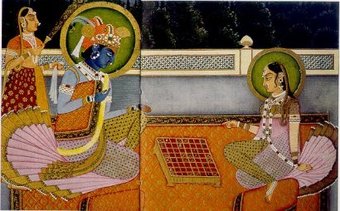
Krishna and Radha playing Chaturanga
Scholars during the reign
of Chandragupta II contributed many scientific advancements in the fields of
astronomy, mathematics, and medicine.
Kalidasa,
considered the greatest poet and dramatist of the Sanskrit language, also belonged
primarily to this period. He wrote plays, such as Shakuntala, which is said to have inspired the famed German writer
and statesman, Johann von Goethe, centuries later. Kalidasa also became
renowned for his study of the shringara, or romantic, element of
literature. The Indian scholar and Hindu philosopher Vatsyayana, authored the Kama Sutra, which became a standard work
on human sexual behavior, while Vishnu Sharma was thought to be the author of
the Panchatantra fables, one of the
most widely-translated, non-religious books in history.
The cultural creativity of the Golden Age of India produced magnificent
architecture, including palaces and temples, as well as sculptures and paintings
of the highest quality. The walls of Buddhist shrines and monasteries were decorated
with colorful frescoes, a type of wall paintings. These showed scenes from the
life of the Buddha, the ascetic and philosopher, who lived in the eastern part
of the Indian subcontinent sometime between 6th and 4th centuries, on
whose teachings the Buddhist religion is based. Some shrines were cut out of
the cliffs, and although dark, they were also decorated with sculptures and
paintings.
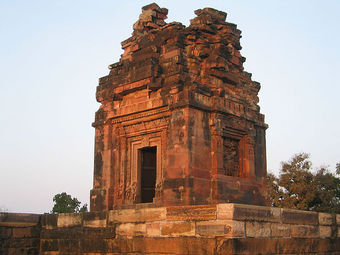
The Dashavatara Temple
The Golden Age of India
produced many temples, decorated with various sculptures and paintings, such as
the Dashavatara Temple, also known as the Vishnu Temple, in central India.
Influence
on East and Southeast Asia
The
Gupta Dynasty promoted Hinduism, but supported Buddhist and Jain
cultures as well. Gupta Buddhist art influenced East and Southeast Asia as
trade between regions increased. The Gupta Empire became an important cultural
center and influenced nearby kingdoms and regions in Burma, Sri Lanka, and
Southeast Asia. Classical forms of Indian music and dance, created under the
Guptas, are still practiced all over Asia today.
Fa
Xian was one of the first Chinese travelers to visit India during the reign of
Gupta Emperor Chandragupta II. He started his journey from China in 399 CE, and reached
India in 405 CE. He recorded all of his observations in a journal that was
eventually published.
During his stay in India, until c. 411 CE, Fa Xian went on a pilgrimage to
Mathura, Kanauj, Kapilavastu, Kushinagar, Vaishali, Pataliputra, Kashi, and
Rajgriha. His writings express pleasure in the mildness of the administrations
in these places.
6.7.3: Decline of the Gupta Empire
After many years of dominance, the Gupta Empire collapsed in 550
CE, due to invasions and weak leadership of successive rulers.
Learning Objective
Understand the decline of the Gupta Empire
Key Points
-
The Gupta Empire flourished under
Chandragupta II, but began to falter under his son, Kumaragupta, and grandson,
Skandagupta. -
The Huna People, also known as
Huns, invaded Gupta territory and caused significant damage to the empire. -
The Gupta Empire ended in 550 CE, when it disintegrated into regional kingdoms after a series of weak rulers and
invasions from the east, west, and north.
Key Terms
- Huna
-
A Central Asian Xionite tribe that consisted of four hordes that repeatedly invaded Gupta territory, and helped cause the downfall of the Gupta Empire.
- Skandagupta
-
Son of Kumaragupta I; the emperor of the Gupta Dynasty from c. 455-467 CE.
- Kumaragupta I
-
Son of Chandragupta II; the emperor of the Gupta Dynasty from c. 415-455 CE.
- Chandragupta II
-
The emperor of the Gupta Dynasty of ancient India from c. 380-415 CE.
The Gupta Empire flourished, in military
and territorial conquests as well as cultural and scholastic advancements, during
the reign of Emperor Chandragupta II. Yet the succeeding rulers, beginning with
Kumaragupta I and then Skandagupta, oversaw the eventual end of the Gupta
Empire through military defeats, devalued money and withering leadership.
Kumaragupta
In
415 CE, Chandragupta II was succeeded by his second son, Kumaragupta I, who
ruled successfully until 455 CE. The late years of his reign, however, faced
difficulties. The Pushyamitras, a tribe of central India, rose up in rebellion
against Kumaragupta, while Gupta territories were invaded by the Western Huna people, also known as White Huns.
Kumaragupta
defeated both groups and celebrated his victory by performing the royal Vedic
ritual of Ashwamedha, or
horse sacrifice, which had previously been performed by his grandfather,
Emperor Samudragupta, to celebrate his own great military victories.
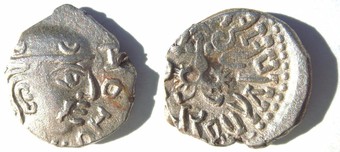
Coin of Kumaragupta I
A silver coin from the reign of Gupta Emperor Kumaragupta I, c. 415-455 CE.
As
his grandfather and father did before him, Kumaragupta also issued news coins
to mark his reign. They were stamped with images of his namesake god, Lord Kumara,
regarded by Hindus as Regent of Earth.
Skandagupta
Upon Kumaragupta’s
death in 455 CE, his son, Skandagupta, assumed the throne and
ruled until c. 467 CE. He is considered the last of the great Gupta rulers
prior to the collapse of the empire.
Skandagupta,
who was celebrated as a great warrior for his victorious clashes with the Huns
during his father’s reign, defeated several rebellions and external threats
from the Huna people, notably an invasion in 455 CE. Although victorious, the
expenses of the wars against the Hunas drained the empire’s resources. The
value of the coinage issued under Skandagupta becoming severely reduced.
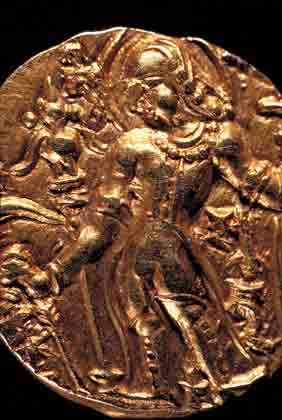
Coin of Skandagupta
A coin emblazoned with the image of Gupta Dynasty Emperor Skandagupta, who ruled c. 455-467 CE.
The Huna and Gupta’s Demise
The
Huna were a Central Asian Xionite tribe that consisted of four hordes: Northern
Huna, also known as the Black Huns; Southern Huna, the Red Huns; Eastern Huna,
the Celestial Huns; and the White Huns, the Western Huna. The White Huns, those
who invaded the Gupta Empire during the reign of Kumaragupta, were also known
as the Hephthalites, and caused great damage to the failing Gupta Empire. Skandagupta
died in 467 CE, and was followed onto the throne by his half-brother, Purugupta,
who ruled from 467-473 CE.
Thereafter
came a succession of weak kings, beginning with Kumaragupta II from 473-476 CE, followed by Budhagupta, the son of Purugupta. The Hephthalites broke through the Gupta
military defenses in the northwest in the 480s, during the reign of Budhagupta,
and by 500 CE much of the empire in northwest was overrun by the Huna.
The empire
thereafter disintegrated into numerous regional kingdoms, ruled by chieftains. A
minor line of the Gupta Clan continued to rule Magadha, one of the 16 Indian
Mahajanapadas, or “Great Countries,” but the Gupta Empire fell by 550
CE.
